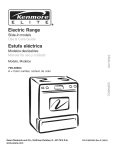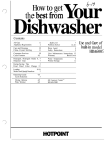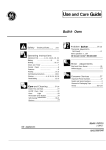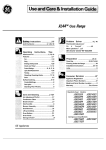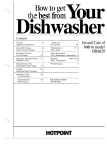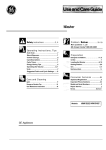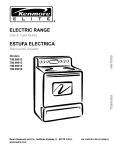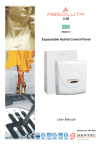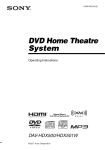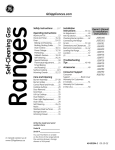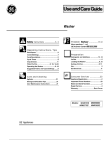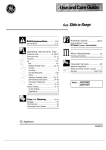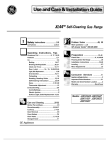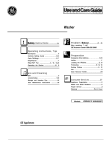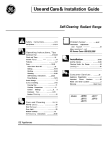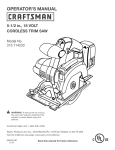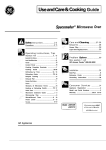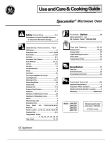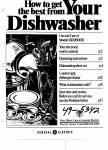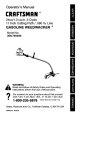Download Hotpoint RGB747GER User's Manual
Transcript
How to get the best from
Aluminum Foil 4,5, 17, 18,20,29
Anti-Tip Device
3,33,40
Oven Vents
Preheating
4,5, 13,30
16
Appliance Registration
Care and Cleaning
2
25-30
Roasting, Roasting Guide 18, 19
Self-Cleaning Instructions 22–24
Clock and Timer
Consumer Services
10, 11
47
12, 16,22,27
Shelves
13
Thermostat Adjustment
Features
Flooring Under Range
Installation Instructions
Leveling
6,7
34
32-44
40
31
Minor Adjustments
Model and Serial Numbers 2,6,34
Oven
Air Adjustment
Baking
Broiler Pan and Rack
Broiling, Broiling Guide
Control Settings
12-24
31,39
14-17
18,20,26
20,21
10
Power Outage
Problem Solver
11, 12
45,46
Safety Instructions
Set the Clock
2-5
10, 11
Set the Timer
Surface Cooking
10, 11
8,9
Burner Grates
Burners
26
25,26
8
9
Control Settings
Cookware Tips
9,38,44,45
Flame Size
Lighting Instructions
8
14, 18,20,22-24
Door Latch
28
Door Removal
Warranty
Installation
Light; Bulb Replacement 13,30
29,31,39
Oven Bottom
GE Answer Center”
800.626.2000
Back Cover
32-44
HUTFOINT
—
Use and Care
&Installation
of Model
RGB747GER
HELP US HELP YOU
Read this book carefully.
It is intended to help you operate
and maintain your new range
properly.
Keep it handy for answers to your
questions.
If you don’t understand something
or need more help, write (include
your phone number):
Consumer Affairs
Hotpoint
Appliance Park
Louisville, KY 40225
Write down the model
and serial numbers.
If ou received
a J’amaged range...
Depending on your range, you’ll
find the model and serial numbers
on a label on the front of the range,
behind the kick panel, storage
drawer or broiler drawer.
These numbers are also on the
Consumer Product Ownership
Registration Card that came with
your range. Before sending in this
card, please write these numbers
here:
Immediately contact the dealer (or
builder) that sold you the range.
Save time and money.
Before you request
service...
Check the Problem Solver in the
back of this book. It lists causes of
minor operating problems that you
can correct yourself.
Model Number
Serial Number
Use these numbers in any
correspondence or service calls
concerning your range.
APPROVEO
@
@
IF’ YOU NEED SERVICE...
To obtain service, see the Consumer
Services page in the back of this
book.
To obtain replacement parts, contact
GE/Hotpoint Service Centers.
We’re proud of our service and
want you to be pleased. If for some
reason you are not happy with the
service you receive, here are three
steps to follow for further help.
FIRST, contact the people who
serviced your appliance. Explain
why you are not pleased. In most
cases, this will solve the problem.
NEXT, if you are still not pleased,
write all the details—including
your phone number—to:
Manager, Consumer Relations
Hotpoint
Appliance Park
Louisville. KY 40225
FINALLY, if your problem is still
not resolved, write:
Major Appliance Consumer
Action Panel
20 North Wacker Drive
Chicago, IL 60606
WARNING: If the information in this manual is not followed exactly, a fire or explosion may result
causing property damage, personal injury or death.
—Do not store or use gasoline or other
flammable vapors and liquids in the vicinity
of this or any other appliance.
—WHAT TO DO IF YOU SMELL GAS
Do not try to light any appliance.
Do not touch any electrical switch; do not
use any phone in your building.
●
●
●
●
2
●
Immediately call your gas supplier from a
neighbor’s phone. Follow the gas supplier’s
instructions.
If you cannot reach your gas supplier, call
the fire department.
Installation and service must be performed
by a qualified installer, service agency or
the gas supplier.
IMPORTANT SAFETY INSTRUCTIONS
i
L
●
Read all instructions before using this appliance.
c After prolonged use of a range, high floor
temperatures may result and many floor
coverings will not withstand this kind of use.
Never install the range over vinyl tile or linoleum
that cannot withstand such type of use. Never
install it directly over interior kitchen carpeting.
IMPORTANT SAFETY NOTICE
The California Safe Drinking Water and Toxic
Enforcement Act requires the Governor of
California to publish a list of substances known
to the state to cause cancer, birth defects or other
reproductive harm, and requires businesses to warn
customers of potential exposure to such substances.
Gas appliances can cause minor exposure to
four of these substances, namely benzene, carbon
monoxide, formaldehyde and soot, caused primarily
by the incomplete combustion of natural gas or
LP fuels. Properly adjusted burners, indicated by
a bluish rather than a yellow flame, will minimize
incomplete combustion. Exposure to these
substances can be minimized by venting with an
open window or using a ventilation fan or hood.
Using Your Range
Don’t leave children alone or unattended where
a range is hot or in operation. They could be
seriously burned,
Q Don’t allow anyone to climb, stand or hang on
the door, storage or broiler drawer (on models
so equipped) or range top. They could damage
the range and even tip it over, causing severe
personal injury.
s CAUTION: ITEMS OF INTEREST TO
CHILDREN SHOULD NOT BE STORED IN
CABINETS ABOVE A RANGE OR ON THE
BACKSPLASH OF A RANGE-CHILDREN
CLIMBING ON THE RANGE TO REACH
ITEMS COULD BE SERIOUSLY INJURED.
●
When You Get Your Range
Have the installer show you the location of the
range gas cut-off valve and how to shut it off
if necessary.
Have your range installed and properly
grounded by a qualified installer, in accordance
●
●
●
●
●
●
with the Installation Instructions. Any adjustment
and service should be performed only by qualified
gas range installers or service technicians,
Plug your range into a 120-volt grounded
outlet only. Do not remove the round grounding
prong from the plug. If in doubt about the grounding
of the home electrical system, it is your personal
responsibility and obligation to have an ungrounded
outlet replaced with a properly grounded, threeprong outlet in accordance with the National
Electrical Code. In Canada, the appliance must be
electrically grounded in accordance with the
Canadian Electrical Code. Do not use an extension
cord with this appliance.
Be sure all packing materials are removed from
the range before operating it to prevent fire or
smoke damage should the packing material ignite.
Locate range out of kitchen traffic path
and out of drafty locations to prevent poor
air circulation.
Be sure your range is correctly adjusted by a
qualified service technician or installer for the
type of gas (natural or LP) that is to be used.
Your range can be converted for use with either
type of gas. See Installation Instructions.
WARNING-A1l ranges can ti and injur
p
1
y
could result. To prevent accidental tipping of the
range, attach an approved Anti-Tip
device to the wall. (See Installation
Instructions.) To check if the device
is installed and engaged properly,
carefully tip the range forward. The
Anti-Tip device should engage and
;.4
prevent the range from tipping over.
If you pull the range out from the
wall for any reason, make sure the
Anti-Tip device is engaged-when you push the range
back against the wall.
A
●
●
Let burner grates and other surfaces cool
before touching them or leaving them where
children can reach them.
Never wear loose fitting or hanging garments
while using the appliance. Be careful when
reaching for items stored in cabinets over the
cooktop. Flammable material could be ignited if
brought in contact with flame or hot oven surfaces
and may cause severe burns.
(continued next page)
3
IMPORTANT SAFETY INSTRUCTIONS
(continued)
For your safety, never use your appliance for
warming or heating the room.
Q Do not use water on grease fires. Never pick up
a flaming pan. Turn off burner, then smother
I flaming pan by covering pan
completely with well-fitting lid, cookie
& sheet or flat tray. Flaming grease outside
a pan can be put out by covering with
baking soda or, if available, a multi-purpose dry
chemical or foam-type fire extinguisher.
Do not store flammable materials in an oven,
a range storage drawer or near a cooktop.
Do not store or use combustible materials,
gasoline or other flammable vapors and liquids
in the vicinity of this or any other appliance.
Q Do not let cooking grease or other flammable
materials accumulate in or near the range.
When cooking pork, follow the directions
exactly and always cook the meat to an internal
temperature of at least 170°F. This assures that, in
the remote possibility that trichina may be present
in the meat, it will be killed and the meat will be
safe to eat.
●
●
●
●
●
●
●
●
●
●
Surface Cooking
Always use the LITE position when
igniting top burners and make sure the
burners have ignited.
Never leave surface burners unattended at
high flame settings. Boilover causes smoking
and greasy spillovers that may catch on fire.
Adjust top burner flame size so it does not
extend beyond the edge of the cookware.
Excessive flame is hazardous.
Use only dry pot holders—moist or damp pot
holders on hot surfaces may result in burns from
steam. Do not let pot holders come
near open flames when lifting
cookware. Do not use a towel
or other bulky cloth in place of a
pot holder.
* To minimize the possibility of burns, ignition
of flammable materials, and spillage, turn
cookware handles toward the side or back of the
range without extending over adjacent burners,
●
●
●
●
●
●
●
●
4
●
●
Always turn surface burner to OFF before
removing cookware.
Carefully watch foods being fried at a high
flame setting.
Never block the vents (air openings) of the
range. They provide the air inlet and outlet that
are necessary for the range to operate properly
with correct combustion. Air openings are located
at the rear of the cooktop, at the top and bottom of
the oven door, and at the bottom of the range,
under the storage drawer.
Do not use a wok if the wok has a round metal
ring that is placed over the burner grate to
support the wok. This ring acts as a heat trap,
which may damage the burner grate and burner
head. Also, it may cause the burner to work
improperly. This may cause a carbon monoxide
level above that allowed by current standards,
resulting in a health hazard.
Foods for frying should be as dry as possible.
Frost on frozen foods or moisture on fresh foods
can cause hot fat to bubble up and over sides
of pan.
Use least possible amount of fat for effective
shallow or deep-fat frying. Filling the pan too
full of fat can cause spillovers when food is added.
If a combination of oils or fats will be used
in frying, stir together before heating or as fats
melt slowly.
Always heat fat slowly, and watch as it heats.
Use a deep fat thermometer whenever
possible to prevent overheating fat beyond the
smoking point.
Use proper pan size-Avoid pans that are
unstable or easily tipped. Select cookware having
flat bottoms large enough to properly contain food
and avoid boilovers and spillovers and large
enough to cover burner grate. This will both save
cleaning time and prevent hazardous accumulations
of food, since heavy spattering or spillovers left
on range can ignite. Use pans with handles that
can be easily grasped and remain cool.
When using glass cookware, make sure it is
designed for top-of-range cooking.
Keep all plastics away from top burners.
Do not leave plastic
items on the
‘--->% . . . . . .
cooktop- they may
melt if left too close to
the vent.
/ent appearance and location vary
Do not leave anv
items on the co;ktop. The hot air from the vent
may ignite flammable items and will increase
pressure in closed containers, which may cause
them to burst.
s To avoid the possibility of a burn, always be
certain that the controls for all burners are at
the OFF position and all grates are cool before
attempting to remove them.
When flaming foods are under the hood, turn
the fan off. The fan, if operating, may spread
the flames.
If range is located near a window, do not hang
long curtains that could blow over the top burners
and create a fire hazard.
If you smell gas, turn off the gas to the range and
call a qualified service technician. Never use an
open flame to locate a leak.
●
3
T
->&-
●
Use only glass cookware that is recommended
for use in gas ovens.
Always remove broiler pan from oven as soon
as you finish broiling. Grease left in the pan can
catch fire if oven is used without removing the
grease from the broiler pan.
Q When broiling, if meat is too close to the flame?
the fat may ignite. Trim excess fat to prevent
excessive flare-ups.
Make sure broiler pan is in place correctly to
reduce the possibility of grease fires.
Q If you should have a grease fire in the broiler
pan, turn off oven, and keep oven door closed to
contain fire until it bums out.
●
●
●
●
Cleaning Your Range
●
●
●
●
Baking, Broiling and Roasting
Self-Cleaning Oven
●
●
●
●
●
●
●
●
●
Do not use oven for a storage area. Items
stored in the oven can ignite.
Stand away from the range when opening the
door of a hot oven. The hot air and steam that
escape can cause burns to hands, face and eyes.
Keep oven free from grease buildup.
Place oven shelves in desired position while
oven is cool.
Pulling out shelf to the shelf-stop is a
convenience in lifting heavy foods. It is also
a precaution against burns from touching hot
surfaces of the door or oven walls. The lowest
position “R” is not designed to slide.
Don’t heat unopened food containers in the
oven. Pressure could build up and the
container could burst, causing an injury.
Don’t use aluminum foil anywhere in the oven
except as described in this book. Misuse could
result in a fire hazard or damage to the range.
When using cooking or roasting bags in oven?
follow the manufacturer’s directions,
Clean only parts listed in this Use
and Care Guide.
Keep range clean and free of
accimula~ions of grease or
spillovers, which may ignite.
●
●
Do not clean door gasket. The door gasket is
essential for a good seal. Care should be taken not
to rub, damage or move the gasket.
Do not use oven cleaners. No commercial oven
cleaner or oven liner protective coating of any kind
should be used in or around any part of the oven.
Before self-cleaning the oven, remove broiler
pan and other cookware.
If You Need Service
●
●
Read “The Problem Solver” in the back of
this guide.
Don’t attempt to repair or replace any part of
your range unless it is specifically recommended
in this guide. All other servicing should be
referred to a qualified technician.
SAVE THESE
INSTRUCTIONS
<
d
FEATURES OF’ YOUR RANGE
~&
Burner Cap
~lcfGQ$;lL;i:ad
-. ——. .
—
)--
//
P
—
(B--J-L
XL_\
‘k
6
&...
-“”””’::
.<.? ..,. ?
,,–..+7
\\ ‘\
..-.-..--LJ
models)
Burner Base
See page
Feature Index
1 Grates, Drip Pans (on models so equipped) and Surface Burners
2 Oven Lamp On/Off Switch
25,26
I
10, 11
3 Oven Control, Clock and Timer
4 Oven Vents
5 Cooktop
4,5, 13,30
I
18,20,26
7 Broiler Pan and Rack
12, 16,22,27
8 Oven Shelves (Easily removed or repositioned on shelf supports.)
I
29
11 Storage Drawer
13 Model and Serial Numbers (On front frame of range, behind storage drawer.)
14 Removable Oven Door (Easily removed for oven cleaning.)
12
4,30
10 Air Vent in Oven Door (Top of Oven Door.)
12 Air Intake (Under Storage Drawer.)
27
8
6 Surface Burner Controls
9 Oven Shelf Supports
13
I
4,30
2,6,34
28
15 Anti-Tip Device (Lower right rear corner on range back.
See Installation Instructions.)
3,33,40
16 Oven Bottom
29,31,39
17 Oven Interior Light
18 Oven Door Latch (Use for Self-Cleaning cycle only.)
13, 30
14, 18,20, 22–24
7
SURFACE COOKING
Electric Ignition
Your surface burners are lighted by electric ignition,
eliminating the need for standing pilot lights with
constantly burning flames.
In case of a power failure, you can light the surface
burners on your range with a match. Hold a lighted
match to the burner, then turn the knob to the LITE
position. Use extreme caution when lighting burners
this way.
Surface burners in use when an electrical power
failure occurs will continue to operate normally.
The electrode of the spark igniter is exposed.
When one burner is turned to LITE, all the burners
spark. Do not attempt to disassemble or clean
around any burner while another burner is on.
An electric shock may result, which could cause
you to knock over hot cookware.
Surface Burner Controls
Before Lighting a Burner
Knobs that turn the surface burners on and off are
marked as to which burners they control. The two
knobs on the left control the left front and left rear
burners. The two knobs on the right control the right
front and right rear burners.
If drip pans are supplied with your range, they
should be used at all times.
● Make sure the grates on the range are in place before
using either burner.
●
The smaller burner (right rear position) will give
the best simmer results.
● The right front burner is higher powered than the
others and will bring liquids to a boil quicker
(natural gas installations only).
●
After Lighting a Burner
To Light a Surface Burner
Push the control knob in and
turn it to LITE. You will hear
a little “clicking” noise—the
sound of the electric spark
igniting the burner.
After the burner ignites, turn the
knob to adjust the flame size.
8
+1111
P
Check to be sure the burner you turned on is the one
you want to use.
● Do not operate a burner for an extended period
of time without cookware on the grate. The finish
on the grate may chip without cookware to absorb
the heat.
● Be sure the burners and grates are cool bef’ore you
place your hand, a pot holder, cleaning cloths or
other materials on them.
●
How to Select Flame Size
Watch the flame, not the knob, as you reduce heat.
The tlame size on a gas burner should match the
cookware you are using.
FOR SAFE HANDLING OF ~,. .....::’
COOKWARE NEVER LET ‘I .~+?
THE FLAME EXTEND
UP THE SIDES OF THE “
COOKWARE. Any flame larger than the bottom
of the cookware is wasted and only serves to heat
the handle.
J
When boiling, adjust the flame so the circle it makes
is about 1/2 inch smaller than the bottom of the
cookware—no matter what the cookware is made of.
Foods cook just as quickly at a gentle boil as they do
at a furious, rolling boil. A high boil creates steam
and cooks away moisture, flavor and nutrition. Avoid
it except for
the few cooking processes that need a vigorous boil.
When frying or warming foods in stainless steel,
cast iron or enamelware, keep the flame down
lower—to about 1/2 the diameter of the pan.
When frying in glass or ceramic cookware, lower
the flame even more.
Top-of-Range Cookware
Aluminum: Medium-weight cookware is
recommended because it heats quickly and evenly.
Most foods brown evenly in an aluminum skillet. Use
saucepans with tight-f-itting lids when cooking with
minimum amounts of water.
Cast-Iron: If heated slowly, most skillets will give
satisfactory results.
Enamelware: Under some conditions, the enamel of
some cookware may melt. Follow cookware
manufacturer’s recommendations for cooking methods.
Glass: There are two types of glass cookware-those
for oven use only and those for top-of-range cooking
(saucepans, coffee and teapots). Glass conducts heat
very slowly.
Heatproof Glass Ceramic: Can be used for either
surface or oven cooking. It conducts heat very
slowly and cools very slowly. Check cookware
manufacturer’s directions to be sure it can be used
on gas ranges.
Stainless Steel: This metal alone has poor heating
properties and is usually combined with copper,
aluminum or other metals for improved heat
distribution. Combination metal skillets usually work
satisfactorily if they are used with medium heat as the
manufacturer recommends.
Wok Cooking
Use of Stove Top Grills
We recommend that you
use only a flat-bottomed
wok. They are avtiilable at
your local retail store.
● Do not use woks that have
support rings. Use of these
%aD
types of woks, with or
without the ring in place,
e
can be dangerous. Placing the
ring over the burner grate may
cause the burner to work improperly resulting in
carbon monoxide levels above allowable current
standards. This could be dangerous to your health.
Do not try to LISC such woks without the ring. You
could be seriously burned if the wok tipped over.
Do not use stove top grills
on your sealed gas burners.
If you use the stove top
grill on the sealed gas
burner it will cause
incomplete combustion
and can result in exposure
to carbon monoxide levels
above allowable current standards.
This can be hazardous to your health.
●
9
FEATURES OF YOUR OVEN CONTROL
(!)
u~M””LJy)jfr#!r+i15Mu!lof I
o
CLEAR
OFF
h
~-
(b
&
BROIL
o
LOCK 0,
N
&
1. CLEARK)FF. Press this pad to cancel all oven
operations except clock and timer.
2. PROGRAM STATUS. Words light up in the
display to indicate what is in time display.
Programmed information can be displayed at any
time by pressing the pad of the operation you
want to see. For example, you can display the
current time of day while the timer is counting
down by pressing the CLOCK pad.
3. TIME DISPLAY. Shows the time of day,
the times set for the timer or automatic
oven operation.
4. OVEN TEMPERATURE AND BROIL
DISPLAY. Shows the oven temperature or the
broil setting selected.
5. FUNCTION INDICATORS. Lights up to show
whether oven is in bake, broil or self-clean mode.
6. INCREASE. Short taps to this pact increase
time or temperature by small amounts. Press
and hold pad to increase time or temperature by
larger amounts.
7. DECREASE. Short taps to this pad decrease
time or temperature by small amounts. Press and
hold pad to decrease time or temperature by
larger amounts.
8. BAKE. Press this pad to select bake function.
9. BROIL. Press this pad to select broil function.
10
BAKE
CLEAN
10. CLEAN. Press this pad to select self-c leaninx
function. See Self-Cjeaning Instructions. 11. COOK TIME. Press this pad for Time Bake
operations.
12. STOP TIME. Use this pad along with COOK
TIME or CLEAN pad to set the oven to start
automatically at a time you select.
13. CLOCK. To set clock, first press CLOCK pad.
Then press the INCREASE or DECREASE pad
to change the time of day. Press the CLOCK pad
to start.
14. TIMER. Press this pad to select timer function.
The timer does not control oven operations. The
timer can time up to 9 hours and 55 minutes.
To set timer, first press TIMER pad. Then press
the INCREASE or DECREASE pad to change
the time.
If “F-” and a number flash on display and the
control beeps, this indicates function error code.
If function error code appears during the self-cleaning
cycle, check oven door latch. The latch handle may
have been moved, even if only slightly, from the
latched position. Make sure the latch is moved to
the right as far as it will go. Press the CLEAR/OFF
pad. Allow oven to cool for one hour. Put oven
back into operation. If function error code repeats.
disconnect power to the range and call for service.
OVEN CONTROL, CLOCK AND TIMER
4
Clock
To Set the Clock
;;:’;:m::ay
@l:=P.d
automatic oven timing functions to
fq’::i!!:’
cannot be changed during a TIME
3. Press the CLOCK pad to start.
Timer
The timer is a minute timer; it does
not control oven operations. The
maximum setting on the timer is9
hours and 55 minutes.
To Set the Timer
o
1. Press the
TIMER pad.
2. Press INCREASE or
DECREASE pad to set the
amount of time on timer.
The timer will start automatically
within a few seconds of releasing
the pad.
The timer, as you are setting it,
will display seconds until 60
seconds is reached.
Then it will display minutes
and seconds until 60 minutes
is reached.
After 60 minutes, it will display
hours (“HR” now appears in
display) and minutes until the
maximum time of 9 hours and
55 minutes is reached.
To Reset Timer
To Cancel Timer
Power Outage?
Press TIMER pad and then press
INCREASE or DECREASE pad
until the time you want shows on
the display.
Press TIMER pad until the word
“TIMER” quits flashing on the
display (about 4 seconds).
After a power outage, when power
is restored, the display will flash
and time shown will no longer be
correct-for example, after a
5-minute power interruption the
clock will be 5 minutes slow.
The display flashes until the clock
is reset. All other functions that
were in operation when the power
went out will have to be
programmed again.
TIMER
I
End of Cycle Tones
Display Messages
The end of cycle tone is a series of three beeps
followed by one beep every six seconds. If you would
like to remove the signal that beeps every six seconds,
press and hold the CLEAR/OFF pad for 10 seconds.
To return the signal that beeps every six seconds,
press and hold the CLEARIOFF pad for 10 seconds.
If “door” appears on the display, the door latch
handle is not moved all the way to the right. Move the
latch handle and cleaning will start. If “LOCK”
appears on the display, the oven door is in the locked
position. BAKE, BROIL and COOK TIME cannot be
set if the door is in the locked position.
11 I
USING YOUR OVEN
Before Using Your Oven
Be sure you understand how to set the controls properly. Practice removing
and replacing the shelves while the oven is cool. Read the information and
tips on the following pages. Keep this book handy where you can refer to it,
especially during the first weeks of using your new range.
Electric Ignition
The oven burner and broil burner are lighted by
electric ignition.
To light either burner, press the pad for the desired
function then press the INCREASE or DECREASE
pad until the desired temperature is displayed. The
burner should ignite within 30-90 seconds.
After the oven reaches the selected temperature, the
oven burner cycles—off completely, then on with a
full flame-to keep the oven temperature controlled.
Power Outage
CAUTION: DO NOT MAKE ANY ATTEMPT TO
OPERATE THE ELECTRIC IGNITION OVEN
DURING AN ELECTRICAL POWER FAILURE.
The oven or broiler cannot be lit during a power
failure. Gas will not flow unless the glow bar is hot.
If the oven is in use when a power failure occurs,
the oven burner shuts off and cannot be re-lit until
power is restored.
Oven Shelves
Shelf Positions
The shelves are designed
with stop-locks so when
placed correctly on the
shelf supports, they will
stop before coming
completely out of the
~
oven and will not tilt
~
when you are removing
food from them or
placing food on them.
When placing cookware on a shelf, pLlll the shelf’ out
to the “stop” position. Place the cookware on the
shelf, then slide the shelf back into the oven. This will
e] iminate reaching into the hot oven.
To remove a shelf from
I————Y’ II
the oven, pull it toward
you, tilt front end upward
and pull shelf out.
To replace, place shelf
on shelf’ support with
stop-locks (curved
extension of shelf)
facing up and toward
rear of oven. Tilt up front and push shelf toward back
of oven until it goes past “stop” on oven wall. Then
lower front of shelf - and push it all the way back.
The oven has five shelf
supports for normal
baking and roasting
identified in this
illustration as A
(bottom), B, C, D and
E (top). It also has a
)
special low shelf
position (R) for roasting extra large items, such
as a large turkey—the
shelf is not designed to
slide out at this position.
Shelf positions for cooking
are suggested on Baking
and Roasting pages.
12
I
I I
Oven Moisture
As your oven heats up, the temperature change of the air in the oven may
cause water droplets to form on the door glass. These droplets are harmless
and will evaporate as the oven continues to heat up.
I I
Oven Vents
The oven is vented through duct openings at the rear
of the cooktop. See Features section. Do not block
these openings when cooking in the oven-it is
important that the flow of hot air from the oven and
fresh air to the oven burners be uninterrupted.
● The vent openings and
-=-*> , . . . .
nearby surfaces may
?7->>~Y~
,(
become hot. Do not
touch them.
>.
-&Y~
● Do not leave plastic
Vent aDDearanc;and 10 CatlOn Varv
items on the cookto~
they may melt if left too
close to the vent.
Handles of pots and pans on the cooktop may
become hot if left too close to the vent.
“ Metal items will become very hot if they are left
on the cooktop and could cause burns.
● Do not leave any items on the cooktop. The hot air
from the vent may ignite flammable items and will
increase pressure in closed containers, which may
cause them to burst.
●
Oven Light
The oven light comes on automatically when the door is opened. Use the
switch on the lower control panel to turn the light on or off when the door
is closed.
Adjusting Oven Thermostat
When cooking a food for the first time in your new
oven, use time given on recipes as a guide. Oven
thermostats, over a period of years, may “drift” from
the factory setting, and differences in timing between
an old and a new oven of 5 to 10 minutes are not
unusual. You may be inclined to think that the new
oven is not performing correctly; however, your new
oven has been set correctly at the factory and is more
likely to be accurate than the oven it replaced.
If you think the oven should be hotter or cooler, you
can adjust it yourself. To decide how much to change
the thermostat, set the oven temperature 25°F higher
or lower than the temperature in your recipe, then
bake. The results of tbis “test” should give you an
idea of how much the thermostat should be changed.
To adjust thermostat:
1. Press the BAKE pad.
2. Select an oven temperature between 500°F. and 550°F.
3. Immediately, before BAKE indicator stops
flashing, press and hold the BAKE pad for about
4 seconds. The red display will change to the oven
adjustment display.
4. The oven thermostat can be adjusted up [o
(+) 35°F. hotter or (–) 35°F. cooler. Use the
INCREASE or DECREASE pads to select the
desired change in the red display.
5. When you have made the adjustment, press the
CLEAR/OFF pad to go back to the time of day
display. Use your oven as you would normally.
NOTE: This adjustment will not affect Broil or
Clean temperatures. It will be remembered when
power is removed.
I
13 I
BAKING
Your oven temperature is controlled very accurately using an oven
control system. We recommend that you operate the range for a number
of weeks to become familiar with your new oven’s performance. If you
think an adjustment is necessary, see the Using Your Oven section.
How to Set Your Range for Baking
Do not lock the oven door with the door latch
during baking. This is used for self-cleaning only.
To avoid possible burns, place the shelves in the
correct position before you turn the oven on.
1. Press the BAKE pad.
u
BAKE
2. Press the INCREASE or DECREASE pad until
desired temperature is displayed.
When the oven starts to heat, the word “ON” and the
changing temperature, starting at 100°F., will be
displayed. When the oven reaches the temperature
you set, a tone will sound.
To change oven temperature during BAKE cycle,
press BAKE pad and then INCREASE or DECREASE
pad to get new temperature.
c)
CLEAR
OFF
3. Press the CLEAWOFF pad when
baking is finished.
TIMED BAKING
The oven control allows you to turn the oven on or off automatically at
specific times that you set. NOTE: Before beginning make sure the oven
clock shows the correct time of day.
To set the clock, first press the CLOCK pad. “TIME” will flash in the
display. Press INCREASE or DECREASE pad until correct time of day is
displayed. Press the CLOCK pad to start.
Do not lock the oven door with the door latch during time baking. This is
used for self-cleaning only.
How to Set Immediate Start and Automatic Stop
The oven turns on right away, cooks for preset length
of time, and turns off automatically at the selected
Stop Time.
To avoid possible burns, place the shelves in the
correct position before you turn the oven on.
1. Press COOK TIME pad.
2. Press INCREASE pad until the desired length of
baking time appears in the display.
3. Press BAKE pad. Attention tone will occur if step 3
is not done.
4. Press INCREASE or DECREASE pad until desired
temperature is displayed.
14
When the oven starts to heat, the word “ON” and the
changing temperature, starting at 100”F., will be
displayed. When the oven reaches the temperature
you set, a tone will sound. The oven will continue to
cook for the programmed amount of time, then shut
off automatically.
5. Remove food from the oven. Remember, even
though oven shuts off automatically, foods continue
cooking after controls are off.
NOTE: Foods that spoil easily such as milk, eggs,
fish, stuffings, poultry and pork should not be allowed
to sit out for more than one hour before or after
cooking. Room temperature promotes the growth of
harmful bacteria. Be sure that the oven light is off
because heat from the bulb will speed h~mful
bacteria growth.
How to Set Delay Start and Stop
Quick Reminder:
1. Press COOK TIME pad.
2. Press lNCREASE/ DECREASE pad to set
cooking time.
3. Press STOP TIME pad.
4. Press INCREASE/ DECREASE pad until
desired Stop Time appears in display.
5. Press BAKE pad.
6. Press lNCREASE/ DECREASE pad to select
oven temperature.
Delay Start and Stop is setting the oven timer to turn
the oven on and off uutmnatically at a later time than
the present time of day.
For example: Let’s say it’s 2:00 and dinner time is
shortly after 7:()(). The recipe suggests 3 hours baking
time at 325°F. Here’s how:
To avoid possible burns, place the shelves in the
correct uosition before .VOLI set Delav. Start.
1. Close the oven door.
o
o
2. Press COOK TIME pad.
COOK
TIME
For 3 hours of’ cooking time, press
INCREASE pad until “3:00”
appears in the display.
4, Press STOP TIME pad.
“5:00’”
on ~ .- .-4,-/
- — amears
-.r ~ --..
I
the display and
j-[;i’
ii’—-1
“STOP TIME”
;$:
flashes. The control I
automatically sets Stop Time by adding the Cook
Time to the time of day. In this example, the time of
day is 2:00 and the Cook Time is 3 hours. Adding 3
hours to the time of’ day equals 5:00.
5. Change Stop Time from 5:00 to 7:00 by pressing
INCREASE pad until “7:00’” appears in
the display.
Press BAKE pad.
.
I
6
.
o
BAKE
7. Press INCREASE pad. The last oven set
temperature appears in the display. Press
INCREASE or DECREASE pad until “325°” is
displayed.
At 4:00, the oven will turn on automatically. The
word “ON” and the changing temperature, -starting at
IOO”F., will bc displayed. When the oven reaches the
temperature you s;t, ~ tone will sound. The oven will
continue to cook for the programmed 3 hours and shut
off automatically at 7:00.
& Remove food from the oven. Remember, even
though oven shuts off automatically, foods continue
cooking after controls are off.
NOTE: When setting your oven for a Delay Start,
never let foods that spoil easily such as milk, eggs,
fish, stuffings, poultry and pork sit out for more than
one hour before or after cooking. Room temperature
promotes the growth of harmful bacteria. Be sure that
the oven light is off because heat from the bulb will
speed harmful bacteria growth.
STOP
TIME
15
BAKING
(continued)
For best baking results, follow these suggestions:
Oven Shelf
Arrange the oven [
shelf or shelves
I
I
\
in the desired
locations while
the oven is cool.
The correct shelf
position depends
on the kind of
food and the
browning desired.
As a general rule,
place-most foods in the middle of the oven, on either
the second or third shelf from the bottom. See the
chart for suggested shelf positions
Type of Food
Shelf Position
Angel f-ood cake
A
Biscuits or muffins
B or C
Cookies or cupcakes
B or C
Brownies
B or C
Layer cakes
B or C
Bundt or pound cakes
A or B
I Pies orpie shells
I Bor C
I Frozen pies
I A(oncookiesheet) \
Casseroles
B or C
Roasting
A or B
Preheating
Preheat the oven if the recipe calls for it. Preheat
means bringing the oven up to the specified
temperature before putting in the food. To preheat, set
the oven at the correct temperature—selecting a
higher temperature does not shorten preheat time.
Preheating is necessary for good results when baking
cakes, cookies, pastry and breads. For most casseroles
and roasts, preheating is not necessary. For ovens
without a preheat indicator light or tone, preheat 10
minutes. After the oven is preheated place the food
in the oven as quickly as possible to prevent heat
from escaping.
Baking Pans
Pan Placement
Use the proper baking pan. The type of finish on the
pan determines the amount of browning that will occur.
● Dark, rough or dull pans absorb heat resulting in a
browner, crisper crust. Use this type for pies.
● Shiny, bright and smooth pans reflect heat, resulting
in a lighter, more delicate browning. Cakes and
cookies require this type of pan.
● Glass baking dishes also absorb heat. When baking
in glass baking dishes, lower the temperature by
25°F. and use the recommended cooking time in
the recipe. This is not necessary when baking pies
or casseroles.
For even cooking and proper browning, there must be
enough room t’or air circulation in the oven. Baking
results will be better if baking pans are centered as
much as possible rather than being placed to the front
or to the back of the oven.
Pans should not touch each other or the walls of the
oven. Allow 1 to I X inch space between pans as well
as from the back of the oven, the door and the sides. If
you use two shelves, stagger the pans so one is not
directly above the other.
16
I
Baking Guides
When using prepared baking mixes, follow package recipe or instructions
for best baking results.
Cookies
When baking cookies, flat cookie sheets (without
sides) produce better-looking cookies. Cookies baked
in a jelly roll pan (short sides all around) may have
darker edges and pale or light browning may occur.
Do not use a cookie sheet so large that it touches the
walls or the door of the oven.
For best results, use only one cookie sheet in the oven
at a time.
T_..._
......7
9
0
Pies
Cakes
For best results, bake pies in dark, rough or dull pans
to produce a browner, crisper crust. Frozen pies in foil
pans should be placed on an aluminum cookie sheet
for baking since the shiny foil pan reflects heat away
from the pie crust; the cookie sheet helps retain it.
When baking cakes, warped or bent pans will cause
uneven baking results and poorly shaped products.
A cake baked in a pan larger than the recipe
recommends will usually be crisper, thinner and drier
than it should be. If baked in a pan smaller than
recommended, it may be undercooked and batter may
overflow. Check the recipe to make sure the pan size
used is the one recommended.
Aluminum Foil
Never cover a shelf entirely with a large cookie sheet
or aluminum foil. This will disturb the heat
circulation and results in poor baking. A smaller sheet
of foil may be used to catch a spillover by placing it
on a lower shelf several inches below the food.
Don’t Peek
Set the timer for the estimated cooking time and do
not open the door to look at your food. Most recipes
provide minimum and maximum baking times such
as “bake 3040 minutes.”
DO NOT open the door to check until the minimum
time. Opening the oven door frequently during
cooking allows heat to escape and makes baking
times longer. Your baking results may also
be affected.
17
ROASTING
Do not lock the oven door with the door latch
during roasting. This is used for self-cleaning only.
Roasting is cooking by dry heal. ‘render IJlca[ or
pou]try can be roasted uncovered in youI” oven.
Roasting temperatures, which should be low and
steady, keep spattering [o a mi ninlul]l.
The oven has a special
low shelf (R) position
just above the oven
bottom. Use it when
extra cooking space is
needed, for example,
when roasting a large
turkey. The shelf is not
designed to slide out tit
this position.
Roasting is really a baking procedure LIscd t’or meats.
Therefore, oven controls are se[ for BAKE or TIME
BAKE. (You mtiy hear a slight clicking s(JLInd,
indicating the oven is working ptx)pcrl y. ) Roast i I]g
is easy; just follow these s(eps:
1. Place the shelf in
A or B position for
small size roasts (3
to 5 Ibs. ) and R
position for larger
roasts. No
preheating is
necessary.
2. Check the weight of the meat. Pljicc the meat fa-side-up, (Jr p(~ultry
breast-side-up, on roasting rack in a shallow pan.
The melting fat will btiste the meat, Select a ptin M
close to the size of’ the meat as possible, ( 13roi Ier
pan with rack is a good pan for this. ) Line broiler
pan with aluminum foil when using pm for mw-in~[ing,
cooking with fruits, cooking heavily cured meu[s,
or basting food during cooking. A\oiLl spi] I ing [hew
Imatcrials inside the oven or inside [he t)~en door.
o
3. Press the BAKE pad.
BAKE
m
4. Press INCREASE or DECREASE
pad until desired temperature is
displayed.
A
When the oven starts to heat, the word
“ON” and the changing temperature,
starting at loOOF.,” will be displayed.
When the oven reaches the temperature
you set a tone will sound.
To change oven temperature during roasting, press the
BAKE pad and then INCREASE or DECREASE pad
to get new tcmperdture.
o
CLEAR
OFF
5. Press the CLEAR/OFF pad when
roasting is finished and then remove
food from oven.
6. Most meats continue to cook slightly while
sttinding, after being removed from the oven.
Standing time recommended for roasts is 10 to 20
minutes. This allows roasts to firm up and makes
them easier [o carve. Internal temperature will rise
about 5[’ to i ()” F.; to compensate for temperature
increase, it’ desired, remove the roast from oven
sooner (ut 5° to 10OF. less than temperature in the
Rousting Guide).
NOTE: You moy wish to TIME BAKE, as described
in the Baking section of’ this book, to turn oven on and
off automuticall y.
Remember that food will continue to cook in the hot
oven and (here fore should be removed when the
desired internal temperature has been reached.
For Frozen Roasts
Dual Shelf Cooking
Frozen roasts of beef’, pork, Ial]lb. etc.. call bc star[ed
without thawing, but allow I () to 25 minutes pcr
pOLLnd additional time (10 minutes per poLIIILi for
roasts under 5 pounds, more time for larger roasts).
● Thaw most frozen poultry before r(ms[ ing to ensure
even doneness. Some commercial (roz.etl poultry can
be cooked successfully without thawing. Follow”
directions given on package label.
This JI1OWS more than one food to be cooked at the
swne time. For example: While roasting a 20 lb.
turkey on shelf (R) a second shelf may be added on
position D so that scalloped potatoes can be cooked
at the same ti mc. Calculate the total cooking time to
enable both dishes to complete cooking at the same
time. Allow 15-20 minutes of additional cooking time
for [he potatoes,”
●
18
Questions and Answers
Q. Is it necessary to check for doneness with a
meat thermometer?
A. Checking the finished internal temperature at the
completion of cooking time is recommended.
Temperatures are shown in Roasting Guide. For
roasts over 8 lbs., check with thermometer at halfhour intervals after half the time has passed.
Q. Why is my roast crumbling when I try to
carve it?
A. Roasts are easier to slice if allowed to cool 10 to
20 minutes after removing from oven. Be sure to
cut across the grain of the meat.
Q. Do I need to preheat my oven each time I cook a
roast or poultry?
A. It is unnecessary to preheat your oven.
Q. When buying a roast, are there any special tips
that would help me cook it more evenly?
A. Yes. Buy a roast as even in thickness as possible,
or buy rolled roasts.
Q. Can I seal the sides of my foil “tent” when
roasting a turkey?
A. Sealing the foil will steam the meat. Leaving it
unsealed allows the air to circulate and brown
the meat.
ROASTING GUIDE
Approximate Roasting Time
Oven
Type
I’emperaturc
Doneness
325°
Rare:
Medium:
Meat
Tender cuts; rib, high quality sirloin
tip, rump or top round”t
325°
325°
325°
Well Done:
Rare:
Medium:
Well Done:
Well Done:
Well Done:
To Warm:
Chicken pieces
325°
3500
Well Done:
Well Done:
Turkey
325”
Well Done:
Lamb leg or bone-in shoulder+
Veal shoulder, leg or loin”~
Pork loin, rib or shouldert
Ham, precooked
Poultry
Chicken or Duck
325°
in Minutes per Pound
6 to 8 lbs.
3 to 5 Ibs.
18-25
24-35
~L3 ]
35–39
3 1–33
3945
20-23
21-25
~4–2R
25-30
30–35
28-33
3040
3545
3040”
3545
18-23 minutes per pound (any weight)
3 to 5 Ibs.
35–40
35$40
10 to 15 Ibs.
16-22
Over 5 Ibs.
30-35
Over 15 Ibs
12-19
Internal
temperature ‘F.
400-1 SO”*
50°–1600
700-1 85°
400 -1500 *
50°–1600
700 -1850
700-1800
700-1800
11 50–1 25°
185°–1900
185°-1900
In thigh:
185°–1900
‘tFor boneless rolled roasts over 6 inches thick, add 5 to I () minutes pcr pound to times given above,
*The U.S. Department of Agriculture says “Rare beef is popular, but you should know that cooking it to only 140°F. means
some food poisoning organisms rntry survive.” (Source: Sat’e Food Book. Your Kitchen Guide. USDA Rev. June 1985. )
19
BROILING
Broiling is cooking food by intense radiant heat from
the upper unit in the oven. Most fish and tender cuts
of meat can be broiled. Follow these steps to keep
spattering and smoking to a minimum.
The oven door should be closed during broiling.
Do not lock the oven door with the door latch
during broiling. This is used for self-cleaning only.
1. If meat has fat or gristle near edge, cut vertical
slashes through both about 2“ apart. If desired, fat
may be trimmed, leaving layer about 1/8” thick.
2. Place meat on broiler rack in broiler pan. Always
use rack so fat drips into broiler pan; otherwise
juices may become hot enough to catch fire.
3. Position shelf on recommended shelf position as
suggested in Broiling Guide.
4. Close the oven door, but do not latch it. If the
door handle is moved to the right during a broil
operation, the door may lock and you may not be
able to open it until the oven has cooled.
5. Press BROIL pad.
6. Select LO Broil (450”F.) by tapping INCREASE
pad once. Select HI Broil (550”F.) by tapping
INCREASE pad twice.
To change from HI Broil to LO Broil, press the
BROIL pad then tap DECREASE pad once.
7. Turn food only once
during cooking. Time
foods for first side per
Broiling Guide.
Turn food, then use times
given for second side as a
guide to preferred doneness.
(Where two thicknesses
and times are given together,
use first times given for thinnest food.)
8. When broiling is completed press the CLEAWOFF
pad. Serve food immediately, and leave pan outside
oven to cool during meal for easiest cleaning.
Use of Aluminum Foil
can use aluminum foil to line your broiler pan and broiler rack. However,
you must mold the foil tightly to the rack and cut slits in it just like the rack.
Without the slits, the foil will prevent fat and meat juices from draining to the
broiler pan. The juices could become hot enough to catch on fire. If you do
not cut the slits, you are frying, not broiling.
YOLI
(
$$%
&$.$$&q
~$@\&s
‘
d
Questions & Answers
Q. When broiling, is it necessary to always use a rack
in the pan?
A. Yes. Using the rack suspends the meat over the
pan. As the meat cooks, the juices fall into the pan,
thus keeping meat drier. Juices are protected by the
rack and stay cooler, thus preventing excessive
spatter and smoking.
O. Should I salt the meat
before broiling?
A. No. Salt draws out the juices and allows them to
evaporate. Always salt after cooking. Turn meat
with tongs; piercing meat with a fork also allows
juices to escape. When broiling poultry or fish,
brush each side often with butter.
20
Q. Do I need to grease my
broiler rack to prevent meat from sticking?
A. No. The broiler rack is designed to reflect broiler
heat, thus keeping the surface cool enough to
prevent meat from sticking to the surface.
However, spraying the broiler rack lightly with a
vegetable cooking spray before cooking will make
clean up easier.
Q. Why are my meats not turning out as brown as
they should?
A. Check to see if you are using the recommended
shelf position. Broil for longest period of time
indicated in the broiling Guide. Turn food only
once during broiling.
1. Always use broiler pan and rack that comes with
your &en. It is designed to minimize smoking and
spattering by trapping juices in the shielded lower
part of the pan.
2. Broiling should always be done with the oven
door closed.
3. For steaks and chops, slash fat evenly around
outside edges of meat. To slash, cut crosswise
through outer fat surface just to the edge of the
meat. Use tongs to turn meat over to prevent
piercing meat and losing juices.
4. If desired, marinate meats or chicken before
broiling or brush with barbecue sauce last 5 to 10
minutes only.
5. When arranging food on pan, do not let fatty
edges hang over sides, which could soil oven with
fat dripping.
6. Broiler does not need to be preheated. However,
for very thin foods, or to increase browning,
preheat if desired.
7. Frozen steaks can be broiled by positioning the
oven shelf at next lowest shelf position and
increasing cooking time given in this guide 1 X
times per side.
BROILING GUIDE
OumtitvamUor
Food
Bacon
Ground Beef
Well Done
Beef Steaks
Rare
Medium
Well Done
I
HI
First Side
Time, Minutes
3%
Second Side
Time, Minutes
3
HI
10-11
4-$
Space evenly.
Up m 8 patties take about same time.
HI
9
12
13
7
5-6
8-Y
Steaks less than I inch thick cook
through before browning. Pan frying
is recommended. Slash lat.
10
I 2- Is
25
6-7
10-12
16-18
LO
30-35
25-30
Reduce time about 5 tu I () minutes per
side for cut-up chicken. Brush each side
with melted butter. Broil skin-side-down
first and broil with dnor closed.
HI
2-3
1/2- I
Space evenly, Place English muffins
cut-side-up and brush with butter,
if desired.
c
HI
13-16
Dn not
turn over
5
Shelf
E&--F
I inch thick
(1 101 X lbs. )
B
B
B
Rare
Medium
Well Done
I X inch thick
(2 to 2!A lbs. )
B
B
B
Chicken
1 whole
(2 to 2X lbs. ),
split lengthwise
B
u
HI or
1.0 Broil
I
Bakery Products
Bread (Toast) or
Toaster Postrics
English Muffins
Lobster Tails
2-4
(6 to 8 oz. each)
3-5
Comments
Arrange in single layer.
ClN through back of’ shell. Spread open.
Brush with melted butter bclore and
tifter halt’ of broiling time.
Fish
1 -lb. fillets 1/4 to
1/2 inch thick
I
B
HI
5
Ham Slices
(orecookcd)
Pork Chops
Well Done
I inch thick
I
c
Lo
x
HI
10
13
4-5
9-12
Slash I’at
B
B
B
B
HI
h’
10
10
17
4-7
10
4-6
12-14
Slmh lat.
c
HI
6
I -2
Lamb Chops
Medium
Well Done
Medium
Well Done
Wieners and similar
precooked sausages,
bratwurst
==Y2 ( 1 inch thick)
about 10 [() 12 oz.
2 ( 1 X inch thick)
about 1 lb.
I -lb. pkg. ( 10)
I
Handle and turn very carefully. Brush
with lemon butter before and during
cooking if desired. Preheat broiler to
increase browninx.
Incretisc time 5 to I () minutes per side
fur 1 X inch thick m home cured ham.
It’ desired, split saus~ges in half
lengthwise; cut intn 5-IU 6-inch pieces.
21
OPERATING THE
SELF-CLEANING OVEN
Normal Cleaning Time: 4 hours
Before a Clean Cycle
Clean top, sides and outside front of oven door with
soap and water. Do not use abrasives or oven cleaners.
● Do not rub or clean the door gasket (B)—the
fiberglass material of the gasket has an extremcl y
low resistance to abrasion. An intact and well-fitting
oven door gasket is essential for energy-efficient
oven operation and good baking results. If you
notice the gasket becoming worn, frayed or damaged
in any way or if it has become displaced on the door,
you should have it replaced.
4. Close and latch the door. Make sure the oven light
(C) is oft.
Oven shelves may be cleaned in the self-cleaning
oven. However, they will darken, lose their luster and
become hard to slide. Wipe the shelf supports with
cooking oil after self-cleaning to make shelves SI ide
more easily.
Caution:
● Drip pans should never be cleaned in the selfcleaning oven.
c Do not use commercial oven cleaners or oven
protectors in or near the self-cleaning oven. A
combination of any of these products plus the high
clean cycle temperatures may damage the porcelain
finish of the oven.
Important
● The oven door must be closed and Ititched and al I
controls must be set correctly for the clean cycle to
work properly.
●
Quick Reminder:
1. Prepare the oven for cleaning.
2. Close and latch the oven door,
3. Press the CLEAN pad.
4. Press the INCREASE pad.
[f you wish to change preset clean time of 4 hours,
press the INCREASE or DECREASE pad until
desired stop time appears in the display.
1. Remove the broiler pan, broiler rack, all cookware
and any alulminum foil frotn the oven-.-they cannot
withstand the high cleaning temperatures. (Oven
shelves may be left in oven. NOTE: Shelves will
discolor after the self-clean cycle. )
2. Wipe up heavy soil on the oven bottom.
I
/L7.-.
-
,
Ilm
A. oven Front Frame
B. Oven Door Gasket
C. Oven Light
B
(-)
3. Clean spatters or spills on the oven front frame (A)
and only that areti on the oven door that is outside
the gasket (B). Do not clean the gasket. Use
detergent and hot water with a soap-filled steel
wool pad, then rinse well with a vinegar and water
mixture. This will help prevent a brown residue
from forming when the oven is heated. Buff these
areas with a dry cloth. Never use a commercial
oven cleaner in or around the self-cleaning oven.
How to Set Oven for Cleaning
1. Follow steps above to prepare the oven
for cleaning.
2. Close the oven door and slide the Ialch handle to
the right as far as it will go.
Never force the door latch handle. Forcing the
handle may damage the door lock mechanism.
3. Press the CLEAN pad.
4. Press the INCREASE or DECREASE
CLEAN
ptid until desired Clean Time is
displayed.
o
22
Clean Time is normally 4 hours. You can change the
Clean Time to anywhere between 2 and 4 hours,
depending on how dirty the oven is. The self-clean
cycle will automatically begin within a few seconds
after the word “CLEAN’> is displayed and the word
“ON” appears on the display. When the oven heats to
a high temperature, the word “LOCK” will be
displayed and, a short time later, the door latch handle
will be locked in position. It will not be possible to
open the oven door until the temperature drops below
the lock temperature.
5. When the LOCK light is off, slide the latch handle
to the left as far as it will go and open the door.
After a Clean Cycle
When the clean cycle is finished, the word “CLEAN”
will go out in the display and the oven will begin to
cool. When the oven temperature has fallen below the
locking temperature the word “LOCK” goes out and
the door can be opened.
After a clean cycle, y~w may notice some white ash in
the oven. .lLIst wipe it LIp with a damp cloth. If white
spo[s remain. remove them with a soap-tilled steel wool
pad. Be sure to rinse thoroughly with a vinegar and
water mixture. These (Icposits are usually a salt residue
that cannot hc rerm)ved by the clean cycle.
if’ the oven is n(X clean after (me ciean cyc]e, the cycle
ma} be r“epc:ltc[i.
How to Delay Start of Cleaning
Delay Start is setting the oven timer to start the clean
cycle automatically at a later time than the present
time of day. NOTE: Before beginning, make sure the
oven clock shows the correct time of day.
Quick Reminder—Delay Start for Self-Clean:
1. Prepare the oven for cleaning.
2. Close and latch the oven door.
3. Press the CLEAN pad.
4. Press the INCREASE pad. If yoLI wish to
change preset clean time of 4 hours, touch the
INCREASE/DECREASE pad until desired
time appears.
5. Press the STOP TIME pad.
Time that appears is 4 hours later than the tirnc of
day. Press the INCREASE pad until the Stop Time
you desire appears in the display. The self-clean
cycle will automatically begin 4 hours before the
Stop Time you select.
For example: Let’s say it’s 7:()() and yOLI wan[ the
oven to begin self-cleaning at !):()() after yoLl” t-e
finished in the kitchen. The oven has been preset to
clean for four hours.
1. Prepare the oven for cleaning.
2. Close the oven door and slide the latch handle [o
the right as far as it will go. Make sure [he oven
light is off.
3. Press the CIXAN pad.
u
and
([IL’ do( )1” C:lll he opm’d
When [[w I.()(’K light is off, slide the latch handle
to ~tw 1~’ft as far as it will go and open the door.
Never f’or-ce the latch handle. Wait until the word
“1. OC’K’” goes out in the display. Forcing the latch
handle may damage the door lock.
8.
CLEAN
(2
5. [’lean Tinlc is l)rcsct for 4 hours. You can change
the clean t imc to anywhere between 2 and 4 hours,
depending on how dirty the oven is. If a shorter
(’lean Time is desired. press the DECREASE pad
unt i I desired [’lean Time is displayed.
6. Press the STOP TIME pad. “ I I :()()”
appetir-s ~)n display and “STOP
STOP
TIME” flashes. The control
automatically sets Stop Time by
TIME
adding
the C’lcun Time to the time of
o
day. In this example, the time of day
is 7:()() anLi the c]~an Time IS 4
hours. Adding 4 hours to the time of
day CqLILlh i I :()().
7. (’bangc Stc)p ‘1’imc from I I :()() 10 I :()() by pressing
the IN(’REASE pact until “ I :()()’” appears in the
displa). The words “DE1 .AY C’LEAN” will also
:lppcar- i n [hc display.
‘1’hc sell’-clc:ln cycle will automatically begin at 9:00
and fini sI) at 1 :()(). ‘1’hc word “ON” will appear on the
display a( 9:()().
When [Ilc> t)~cn l(~cks, the word “l, (X’K” will be
displaye~l and a sh(~rt [imc later, the door latch handle
wi I I he I{)ckcd i n positi(m. 1( will not be possible to
open (he oven dtmr unti I [he temperature drops below
the lt)ck tcrl][]er;ttLlr”~’.
When the clean cycle is l’inished, the word “CLEAN”
wil I go out in [hc display and the oven will begin to
ctx)l. When the ()~cn tcn}pcraturc has fallen below
(hc locking tcmper”aturc [he w(ml “LOCK” goes out
4. Press the INCREASE pad. The oven
is set.
(Ccul[ilfucd trcli p(i,qf’)
A
—--.—-— — . .
23
OPERATING THE SELF-CLEANING OVEN
(continued)
Questions and Answers
Q. If my oven clock is not working, can I still selfclean my oven?
A. If the clock is not working then the entire control is
not working. If the clock is not set to the correct
time of day you will not be able to set a delay
clean to end at a specific time.
Q. Can I use commercial oven cleaners on any part
of my self-cleaning oven?
A. No cleaners or coatings should be used around any
part of this oven. If you do use them and do not
thoroughly rinse the oven with water, wiping it
absolutely clean afterwards, the residue can scar
the oven surface and damage metal parts the next
time the oven is automatically cleaned.
Q. What should I do if excessive smoking occurs
during cleaning?
A. This is caused by excessive soil. Press the
CLEAR/OFF pad. Open windows to rid room
of smoke. Wait until the oven has cooled (about
20-30 minutes) and the word “LOCK” is off in
the display. Wipe up the excess soil and reset the
clean cycle.
Q, Is the “crackling” sound I hear during
cleaning normal?
A. Yes. This is the sound of the metal heating
and cooling during both the cooking and
cleaning functions.
24
Q. Should there be any odor during the cleaning?
A. Yes, there may be a slight odor during the first few
cleanings. Failure to wipe out excessive soil might
also cause a strong odor when cleaning.
Q. What causes the hair-like lines on the enameled
surface of my oven?
A. This is a normal condition, resulting from heating
and coaling during cleaning. These lines do not
affect how your oven performs.
Q. Why do I have ash left in my oven after cleaning?
A. Some types of soil will leave a deposit which is
ash. It can be removed with a damp sponge or cloth.
Q. My oven shelves do not slide easily. What is
the matter?
A. After many cleanings, oven shelves may become
so clean they do not slide easily. To make shelves
slide more easily, after each self-cleaning function
dampen fingers with a small amount of cooking oil
and rub lightly over sides of shelf where they
contact shelf supports.
Q. My oven shelves have become gray after the
self-clean cycle. Is this normal?
A. Yes. After the self-clean cycle, the shelves may
lose some luster and change to a deep gray color.
Q. The word “door” appeared on the display when
I selected the Clean Cycle. What is wrong?
A. The door latch handle must be moved all the way
to the right. Move the latch handle and cleaning
will start.
CARE AND CLEANING
,w. - :., <
&..,,
.:,
!..
Proper care and cleaning are important so your range will give you efficient
and satisfactory service. Follow these directions carefully in caring for it to
help assure safe and proper maintenance.
BE SURE ELECTRICAL POWER IS DISCONNECTED BEFORE
CLEANING ANY PART OF YOUR RANGE.
Burner Assemblies
Grate
CAUTION: DO NOT OPERATE THE
BURNER WITHOUT ALL BURNER
PARTS AND DRIP PANS (IF SO EQUIPPED)
IN PLACE.
The burner assemblies should be cleaned thoroughly
after spillovers.
Turn all controls OFF before removing burner parts
and drip pans (if so equipped).
The burner grates, caps, burner heads and drip pans
(if so equipped) can be lifted off, making them easy
to clean.
- Electrode
The electrode of the
spark igniter is
exposed. When
one burner is turned
.-’
to LITE, all the burners=
spark. Do not attempt to
disassemble or clean around any burner while
another burner is on. An electric shock may result,
which could cause you to knock over hot cookware.
Burner Caps
Lift off when cool. Wash burner caps in hot, soapy
water and rinse with clean water. If desired, soak up
to 30 minutes and scour with a plastic scouring pad to
remove burned-on food particles. Dry them in a warm
oven or with a cloth—don’t reassemble them wet.
Burner Base
The burner base (the part of the burner fastened to the
cooktop) may be cleaned with a soft brush and a mild
cleanser. Clean all food residues from around spark
electrode. Do not use steel wool; small bits of steel
wool will short out the electrode. Rinse well.
(continued next page)
25
CARE AND CLEANING
(continued)
Burner Heads
The holes in the burners of your range, ‘-””
2
and the spark electrodes, must be kept
l/.\/. ~\.\ \l”
clean at all times for proper ignition and a
an even, unhampered flame.
You should clean the burner heads routinely, especially
after bad spi]lovers, which could clog these holes.
Wipe off burner heads. If heavy spillover occurs,
remove burner heads from range.
Remove the burner grate and burner cap. Then lift the
burner head straight up.
To remove burned-on food, soak the burner head
upside-down in a solution of Imild liquid detergent and
hot water. Soak the burner head for 20 to 30 minutes.
If the food doesn’t rinse off completely, scrub it with
soap and water and a soft brush or plastic scouring pad.
For more stubborn stains, use a cleanser like Soft
Scrub@ brand or Bon Ami($ brand. Rinse well to
remove any traces of the cleanser that might clog the
burner openings. Do not use steel wool because it will
clog the burner openings and scratch the burners. If
the holes become ck)gged, clean them with a toothpick.
Do not clean the burner head in the self-cleaning oven.
Bef’ore putting the burner head back, shake out excess
water and dry it thoroughly by setting it in a warm
oven for 30 minutes. Then place it back in the range,
making sure the pin in the burner base goes in the
hole in the burner head, and that the burner heads are
properly seated and level.
Burner Grates
washed regularly
,,
after spillovers. Wash them in hot, soapy water and
rinse with clean water. After cleaning, dry them
thoroughly by putting them in a warm oven for a few
minutes. Don’t put the grates back on the range while
they are wet. When replacing the grates, be sure
they’re positioned securely over the burners.
::::::0’ -
To get rid of’ burned-on food, place the grates in
a covered container (or plastic bag) with 1/4 cup
ammonia to loosen the soil. Then scrub with a
soap-filled scouring pad if necessary.
Although they’re durable, the grates will gradually
lose their shine, regardless of’ the best care you can
give them. This is due to their continual exposure to
high temperatures.
Do not operate a burner for an extended period of
time without cookware on the grate. The finish on the
grate may chip without cookware to absorb the heat.
Drip Pans
Broiler Pan and Rack
(on some models)
Remove the grates
and lift out the drip
pans. Drip pans can
beceanedn
~~~~
dishwasher or by
hand. Place them in
a covered container (or plastic bag) with l/4 cup
ammonia to loosen the soil. Then scrub with a soapfilled scouring pad if necessary.
Caution: Drip pans CANNOT be self-cleaned.
26
After broiling, remove the
broiler pan and rack from
the oven. Remove the rack
from the pan. Carefully
I
pour out the grease in the I
I
I
I
Dan into a rmmer container. I
I
I
I
I
If food has burned on,
I
:
sprinkle the rack with
—
detergent while hot and
cover with wet paper
towels or a dishcloth. That way, burned-on foods will
soak loose while the meal is being served.
Wash; scour if necessary. Rinse and dry. The broiler
pan and rack may also be cleaned in a dishwasher.
Do not store a soiled broiler pan and rack anywhere
in the range. Do not clean in self-cleaning oven.
,,
E’
Cooktop Surface
To avoid damaging the
*
porcelain enamel surface
of’ the cooktop and to
:>
4
prevent it from becoming
u~
..-.
dull, clean up spills right
“- \...––
Q o
m
away. Foods with a lot of
acid -( tomatoes, sauerkraut, fruit juices, etc. ) or foods
with high sugar content could cause a dull spot ifallowed to set.
When the surface has cooled, wash and rinse. For
other spills such as fat smatterings, etc., wash with
soap and water once the surface has cooled. Then
rinse and polish with a dry cloth.
Do not store flammable materials in an oven or
near the cooktop. Do not store or use combustible
materials, gasoline or other tlammable vapors and
liquids in the vicinity of this or any other applitincc.
Control Panel and Knobs
It’s o good idea to wipe the control panel after each
use of the oven. Clean with mild soap and water or
vinegar and water, rinse with clean water and polish
dry with a soft cloth.
Do not use abrasive cleansers, strong liquid cleaners,
plastic scouring pads or oven cleaners on the control
panel—they will damage the finish. A 50/50” solution
of vinegar and hot water works well.
The control knobs may be
,{)
.,/”= ~
removed for easier cleaning.
d.+
~
To remove knob. pull it
~
straight off the stem. If knob Q
~
‘
—
is difficult to rclnove, place ~
Q
a towel or dishcloth between
the knob and control panel and pull gently. Wash the
knobs in soap and water or a vinegar and hot water
solution but do not soak.
To clean outside glass finish, use a glass cleaner. Do
not allow the water or cleaner to run down inside
openings in the glass while cleaning.
Metal parts can be cleaned with soap and w~iter. Do
not use steel wool, abrasives. ammonia, acids or
commercitil oven cleaners. Dry with a soft cloth.
Oven Shelves
*f:.
.4,
.:
.,.~.”>
n
k
a. ❑
>
Shelves can be cleaned by hand using soap and water
or with an abrasive cleanser. After cleaning, rinse the
shelves with clean water and iirv. To remove heavy,
burned-on soil, you may use sc~uring pads. After”
scrubbing, wash with soapy water, rinse and dry.
Shelves may also be cleaned in self-cleaning oven,
but will discolor and lose some luster. See the SelfCletining section.
(Cotllitf[d[,(l Ilct-l p(t<qe)
27
CARE AND CLEANING
(continued)
Lift-Off Oven Door
The oven door is removable but it is heavy. You may
need help removing and replacing the door.
To remove the door, open it a few inches to the
special “stop” position that will hold the door open.
Grasp firmly on each side and lift the door straight up
and off the hinges.
NOTE: Be careful not to place hands between the
spring hinge and the oven frame as the spring hinge
could snap back and pinch your fingers.
To replace the door, make sure the hinges are in the
“out” position. Position the slots in the bottom of the
door squarely over the hinges. Then lower the door
slowly and evenly over both hinges at the same time.
TO CLEAN THE DOOR:
(Do not immerse door in water.)
Inside of door:
● Because the area inside the gasket is cleaned during
the self clean cycle, you do not need to clean this by
hand. Any soap left on the liner causes additional
stains when the oven is heated.
● The area outside the gasket can be cleaned with a
scouring pad.
● Do not rub or clean the door gasket—the fiberglass
material of the gasket has an extremely low
resistance to abrasion. An intact and well-fitting
oven door gasket is essential for energy-efficient
oven operation and good baking results. If you
notice the gasket becoming worn, frayed or damaged
in any way or if it has become displaced on the door,
you should have it replaced.
Inside’
Gasket
Gas’ket
Out;ide
Gasket
Outside of door:
● Use soap and water to thoroughly clean the top,
sides and front of the oven door. Rinse well. You
may also use a glass cleaner to clean the glass on
the outside of the door.
● Spillage of marinades, fruit juices, tomato sauces
and basting materials containing acids may cause
discoloration and should be wiped up immediately.
When surface is cool, clean and rinse.
● Do not use oven cleaners, cleansing powders or
harsh abrasives on the outside of the door.
28
I
Removable Storage Drawer
The storage drawer is a good place to store cookware
and bakeware. Do not store plastics and flammable
material in the drawer.
v
Do not overload the storage drawer. If the drawer is
too heavy, it may slip off the track when opened.
The storage drawer may be removed for cleaning
under the range. Clean the storage drawer with a
damp cloth or sponge. Never use harsh abrasives or
scouring pads.
To remove storage drawer:
1. Pull drawer straight out until it stops.
2. Lift drawer until stops on drawer clear stops
on range.
3. Again pull drawer out until it hits second set
of stops.
4. Tilt front of drawer up and free of range.
To replace storage drawer:
1. Set the stops on the back of the drawer over the
stops in the range.
2. Slide drawer evenly and straight back, so that the
rails in the range are engaged.
3. Push drawer back until second stops on drawer hit
stops in the range. Tilt drawer up and over these.
4. Slide drawer the rest of the way in.
Oven Bottom
The oven bottom has a porcelain enamel finish. To
make cleaning easier, protect the oven bottom from
excessive spillovers by placing a cookie sheet on the
shelf below the shelf you are cooking on. You can use
aluminum foil if you do not cover the whole shelf.
This is particularly important when baking a fruit pie
or other foods with a high acid content. Hot fruit
fillings or other foods that are highly acidic (such as
milk, tomatoes or sauerkraut, and sauces with vinegar
or lemon juice) may cause pitting and damage to the
porcelain enamel surface and should be wiped up
immediately. Take care not to touch hot portion of oven.
If a spillover does occur on
the oven bottom, allow the
oven to cool first. You can
then clean the oven bottom
with soap and water, an
abrasive cleanser or
scouring pads.
● Rinse well to remove any
soap before self-cleaning.
29
CARE AND
CLEANING
(continued)
Oven Air Vents
“m~~m
--77>
Never block the vents (air openings) of the range. They provide the air
~~
inlet and outlet that are necessary for the range to operate properly with --’”
correct combustion. Air openings are located at the rear of the cooktop, at
the top and bottom of the oven door, and at the bottom of the range, under ->?=
the storage drawer.
Oven Lamp Replacement
CAUTION: Before replacing your oven bulb,
disconnect electrical power to the range at the
main fuse or circuit breaker panel. Be sure to let
the lamp cover and bulb cool completely.
The oven lamp (bulb) is covered with a removable
glass cover that is held in place with a bail-shaped
wire. Remove oven door, if desired, to reach cover
easily.
To remove:
1. Hold hand under cover so it doesn’t fall when
released. With fingers of same hand, firmly push
back wire bail until it clears cover. Lift off cover.
DO NOT REMOVE ANY SCREWS TO
REMOVE COVER.
2. Do not touch hot bulb with a wet cloth. Replace
bulb with a 40-watt household appliance bulb.
To replace cover:
1. Place it into groove of lamp receptacle. Pull wire
bail forward to center of cover until it snaps into
place. When in place, wire holds cover firmly. Be
certain wire bail is in depression in center of cover.
2. Connect electrical power to the range.
Metal Parts
Glass Surfaces
Do not use steel wool, abrasives,
ammonia or commercial oven
cleaners. To safely clean surfaces;
.......
wash, rinse and then dry with a - @’ -:., .:<: “>,; .
&
soft cloth.
To clean the outside glass
finish, use a glass
cleaner. Rinse and polish
with a dry cloth. Do not
m
allow the water or
cleaner to run down
inside openings in the
.U
glass while cleaning.
--&.& 1’
.
30
Broil and Bottom Burner Air Adjustment Shutters
The combustion quality of burner flames needs to be
determined visually. See the Installation Instructions
and the Problem Solver sections in this book. Air
adjustment shutters for the top (broil) and bottom
(oven) burners regulate the flow of air to the flames.
To determine if the bottom burner flames are proper,
remove the oven bottom and the burner baffle.
To remove the oven bottom:
1. Remove the knurled screws holding down rear of
oven bottom.
2. Grasp the oven bottom at finger slots on each side.
3. Lift the rear of the oven bottom enough to clear the
lip of the range frame, then pull out.
The air adjustment shutter for the top (broil) burner
is in the center of the rear wall of the oven.
(See Installation Instructions in this book.)
Burner Baffle
—–Remove
Screw
-r”-~
The flames for the top (broil) burner should burn
steady with approximately 1“ blue cones and should
not extend out over the edges of the burner baffle.
The shutter for the bottom (oven) burner is near the
back wall behind the storage drawer, or kick panel.
To adjust the flow of air to either burner, loosen the
Phillips head screw and rotate the shutter to allow
more or less air into the burner tube as needed.
To remove the burner baffle, use a nut driver
to remove the 1/4” hex head screw shown in the
illustration above. Do not remove any other screws.
Pull baffle straight out until it is free from the slot
that holds it at rear of’ oven.
The flames should have 1/2” to 3/4” blue cone with no
yellow tipping. When the baffle is back in place, the
flames will resettle.
31
INSTALLATION INSTRUCTIONS
FOR YOUR SAFETY
IMPORTANT
If you smell gas:
1. Open windows.
z. Don’t touch electrical switches.
3. Extinguish any open flame.
4. Immediately call your gas supplier.
Remove all packing material and
literature from oven before connecting
gas and electrical supply to range.
DIMENSIONS AND CLEARANCES
FOR YOUR SAFETY
Provide adequate clearances between the range
and adjacent combustible surfaces.
Do not store or use combustible
materials, gasoline or other flammable
vapors and liquids in the vicinity of this
or any other appliance.
BEFORE YOU BEGIN
Read these instructions completely and
carefully.
IMPORTXNT: Save these instructions
for the local electrical inspector’s use.
INS’IXLLER: Leave these instructions
with the appliance after installation is
completed.
CONSUMER: Keep this Use and Care
Guide and the Installation Instructions
for tidure use.
This appliance must be properly grounded.
IL
Height 46)’2”
I
T
46%”
WARNING
Improper installation, adjustment,
alteration, service or maintenance can
cause injury or property damage. Refer to
this manual. For assistance or additional
information, consult a qualified installer,
service agency, manufacturer (dealer) or
the gas supplier.
CAUTION
Do not attempt to operate the oven of
this range during a power failure.
32
\
Depth with Door Open IX
18,, ~:
eild
\
\\
\ -. -- --p
\
--- 4’*
IMPORTANT SAFETY INSTRUCTIONS
Installation of this range must conform with
local codes, or in the absence of local codes,
with the National Fuel Gas Code, ANSI
2223.1, latest edition. In Canada, installation
must conform with the current Natural Gas
Installation Code, CAN/CGA-B149.l or the
current Propane Installation Code, CAN/CGAB149.2, and with local codes where applicable.
Ilis range has been design-certified by the
American Gas Association according to ANSI
Z21.1, latest edition and Canadian Gas Association
according t.o CAN/CGA-l.l latest edition. As with
any appliance using gas and generating heat,
there are certain safety precautions you should
follow. You will find these precautions in the
Important Safety Instructions in the front of this
book. Read them carefully.
● Have your range installed by a qualified
installer or service technician.
. Your range must be electrically grounded in
accordance with local codes or, in the absence
of local codes, in accordance with the National
Electrical Code (NSI/NFPA 70, latest edition).
In Canada, electrical grounding must be in
accordance with the current CSA C22.1 Canadian
Electrical Code Part 1 and/or local codes. See
Electrical Connections in this section.
. Before installing your range on linoleum or
any other synthetic floor covering, make sure
the floor covering can withstand 180” I? without
shrinking, warping or discoloring. Do not install
the range over carpeting unless a sheet of 1/4”
thick plywoocl or similar insulator is placed
between the range and carpeting.
● Make sure the wall coverings around the
range can withstand heat generated by the
range up to 200° E;
● Avoid placing cabinets above the range. To
reduce the hazard caused by reaching over the
open flames of operating burners, install a
ventilation hood over the range that projects
forward at least 5“ beyond the front of the cabinets.
. The ventilating hood must be constructed of
sheet metal not less than 0.0122” thick. Install
above the cooktop with a clearance of not less
than 1/4” between the hood and the underside
of the combustible material or metal cabinet.
The hood must beat least as wide as the
appliance and centered over the appliance.
Clearance between the cooking surface and the
ventilation hood surface MUST NEVER BE
LESS THAN 24 INCHES.
If cabinets are placed above the range, allow a
minimum clearance of 30” between the cooking
surface and the bottom of unprotected cabinets.
● If a 30” clearance between cooking surface
and overhead combustible material or metal
cabinets cannot be maintained, protect the
underside of the cabinets above the cooktop with
not less than 1/4” insulating millboard covered
with sheet metal not less than 0.0122” thick.
● Clearance between the cooking surface and
protected cabinets MUST NEVER BE LESS
THAN 24 INCHES. The vertical distance from
the plane of the cooking surface to the bottom of
adjacent overhead cabinets extending closer than
1“ to the plane of the range sides must not be
less than 18”. (See Dimensions and Clearances
illustration in this section.)
● Caution: Items of interest to children should
not be stored in cabinets above a range or on the
backsplash of a range-children climbing on the
range to reach items could be seriously injured.
P;.4
WARNING
All ranges can tip and injury could
result. To prevent accidental tipping
@ of the range, attach an approved
Anti-Tip device to the wall. (See
;.4
Installing the Anti-Tip Device in this
section.) To check if the device is
A installed and engaged properly,
carefully tip the range forward. The
Anti-Tip device should engage and prevent the
range from tipping over.
If you pull the range out from the wall for any
reason, make sure the Anti-Tip device is engaged
when you push the range back against the wall.
● For your safety, never use your range for
warming or heating the room. Your oven and
range top are not designed to heat your kitchen.
Top burners should not be operated without
cookware on the grate. Such abuse could result
in fire and damage to your range and will void
your warranty.
● Do not store or use combustible materials,
gasoline or other flammable vapors and liquids
in the vicinity of this or any other appliance.
Explosions or fires could result.
● Do not use oven for a storage area. Items
stored in the oven can ignite.
c Do not let cooking grease or other flammable
materials accumulate in or near the range.
(continued next page)
●
33
INSTALLATION INSTRUCTIONS
(continued)
GENERAL
● See Dimensions and Clearances in this section
for all rough-in and spacing dimensions. Ilese
dimensions must be met for safe use of your range.
The location of the electrical outlet and pipe opening
(see Gas Pipe and Electric Outlet Locations) may
be adjusted to meet specific requirements.
● The range may be placed with 0“ clearance
(flush) at the back wall and side walls of the range.
TOOLS YOU WILL NEED
c Phillips and flat-blade screwdrivers
Pencil and ruler
Two pipe wrenches (one for backup)
“ l%” open-end or adjustable wrench
● Nut drivers or wrenches: 3/16” and 1/4”
●
●
ADDITIONAL MATERIALS YOU MhY NEED
●
LOCATION
Do not locate the range where it maybe subject
to strong drafts. Any openings in the floor or wall
behind the range should be sealed. Make sure
the openings around the base of the range that
supply fresh air for combustion and ventilation
are not obstructed by carpeting or woodwork.
PROTECT YOUR FLOOR
Your range, like many other household items, is
heavy and can settle into soft floor coverings
such as cushioned vinyl or carpeting. IJse care
when moving the range on this type of flooring.
It is recommended that the following simple and
inexpensive instructions be followed to protect
your floor.
The range should be installed on a sheet of plywood
(or similar material). When tkeflkw covering ends
at the front of the range, the area that the range
will rest on should be built up with plywood to
the same level or higher than the floor covering.
This will allow the range to be moved for cleaning
or servicing.
MODEL AND SERIAL NUMBER LOCATION
Depending on your range, you’ll find the model
and serial numbers on a label on the front frame
of the range, behind the storage drawer, kick
panel or broiler drawer.
34
Gas line shut-off valve
Pipe joint sealant or UI.-approved pipe thread
tape with Teflon* that resists action of natural
and LP gases
● Flexible metal appliance connector (1/2” I. D.)
A 5-foot length is recommended for ease of
installation but other lengths are acceptable.
Never use an old connector when installing a
new range.
● Flare union adapter for connection to gas
supply line (3/4” or 1/2” NPrx 1/2” I. D.)
● Flare union adapter for connection to pressure
regulator on range (1/2” NPTx 1/2” I. D.)
●
‘Teflon: Registered
trademark of I)uPont
PREWRATION
● Remove all tape and packaging. Lift up the
cooktop (on models with dual burners) and remove
any packing material under it. Make sure the
dual burners are properly seated and level.
● Remove plastic film that covers some chrome
parts (around oven door, side trim).
● Take the accessory pack out of the oven.
● Check to be sure that no range parts have
come loose during shipping.
ElpfCOviDEADEOuATE GAS SUPPLY
Your range is designed to operate at a pressure
of 4“ of water column on natural gas or, if designed
for LP gas (propane or butane), 10” of water
column. Make sure you are supplying your range
with the type of gas for which it is designed. This
range is convertible for use on natural or propane
gas, if you decide to use this range on a different
type of gas, conversion adjustments must be
made by a service technician or other qualified
person before attempting to operate the range on
that gas.
For proper operation, the pressure of natural gas
supplied to the regulator must be between 4“ and
13” of water column. For LP gas, the pressure
supplied must be between 10” and 13” of water
column. When checking for proper operation of
the regulator, the inlet pressure must beat least
1“ greater than the operating (manifold) pressure
as given above. The pressure regulator located
at the inlet of the range manifold must remain in
the supply line regardless of whether natural or
LP gas is being used. A flexible metal appliance
connector used to connect the range to the gas
supply line should have an I.D. of 1/2” and be
5 feet in length (shorter and longer lengths are
acceptable) for ease of installation. In Canada,
flexible connectors must be single wall metal
connectors no longer than 6 feet in length.
Gas Pipe and Electric Outlet Locations
(cwrfitlf(f,d tl[,.rt p[I<yf,)
2 CONNECT THE RMGE TO GAS
10
Shut off the main gas supply valve before
disconnecting the old range and leave it off until
new hook-up has been completed. Don’t forget
to relight the pilot on other gas appliances when
you turn the gas back on.
Because hard piping restricts movement of the
range, the use of an A. G.A.-certitled flexible
metal appliance connector is recommended
unless local codes require a hard-piped connection.
Never use an old connector when installing a
new range. If the hard piping method is used,
you must carefully align the pipe; the range
cannot be moved after the connection is made.
To prevent gas leaks, put pipe joint compound
on, or wrap pipe thread tape with Teflon*
around, all male (external) pipe threads.
Teflon: Registered trademark of DuPont
35
INSTALLATION INSTRUCTIONS
CONNECT THE RANGE TO GAS
Flexible Connector Hookup
Pressure
Regulator ~
.
** -.
0-
(..))
90°Elbow~
Q(provided)
I@@
‘..
Flex
f?
~ Connector
Adapter
(6 ft. max.)
~ Adapter
#
-ll,,:,,/,=!$
Gas
Shut-off
~ Valve
Rigid Pipe Hookup
1. Install a manual gas line shut-off valve in the
gas line in an easily accessed location outside of
the range. Make sure everyone operating the
range knows where and how to shut off the gas
supply to the range.
2. Install male 1/2” flare union adapter to the
1/2” NPT internal thread elbow at inlet of
regulator. Use a backup wrench on the regulator
fitting to avoid damage.
When installing the range from the front,
remove the 90° elbow for easier installation.
3. Install male 1/2” or 3/4” flare union adapter
to the NPT internal thread of the manual shutoff valve, taking care to back-up the shut-off
valve to keep it from turning.
4. Connect flexible metal appliance connector
to the adapter on the range. Position range
to permit connection at the shut-off valve.
5. When all connections have been made, make
sure all range controls are in the off position and
turn on the main gas supply valve. Use a liquid
leak detector at all joints and connections to
check for leaks in the system.
CAUTION: DO NOT USE A FLAME TO
CHECK FOR GAS LEAKS.
Pressure
+ Regulator
(,))
;;;::::+
Q r~mm1_90::w
Nipple
.
a
Union
o
~Z
36
~ Iron Pipe
~~j
When using test pressures greater than 1/2 psig
to pressure test the gas supply system of the
residence, disconnect the range and individual
shut-off valve from the gas supply piping. When
using test pressures of 1/2 psig or less to test the
gas supply system, simply isolate the range from
the gas supply system by closing the individual
shut-off valve.
❑ ELECTRICAL
CONNECTIONS
Electrical Requirements
120volt, 60 Hertz, properly grounded branch
circuit protected by a 15-amp or 20-amp circuit
breaker or time delay fuse.
Extension Cord Cautions
Because of potential safety hazards associated
with certain conditions, we strongly recommend
against the use of an extension cord. However,
if you still elect to use an extension cord, it is
absolutely necessary that it be a UL-listed,
3-wire grounding-type appliance extension cord
and that the current carrying rating of the cord
in amperes be equivalent to, or greater than,
the branch circuit rating.
Grounding
IMPORTANT-(Please read carefully)
FOR PERSONAL SAFETY, THIS APPLIANCE
MUST BE PROPERLY GROUNDED.
The power cord of this appliance is equipped
with a three-prong (grounding) plug which
mates with a standard three-prong grounding
wall receptacle
PREFERRED
‘
to minimize the
METHOD
possibility of
IQ
electric shock
o
4
hazard from
<,
this appliance.
n
The customer
ENSURE PROPER
should have the
GROUND EXISTS
wall receptacle
BEFORE USE
and circuit
@p
checked by a
qualified electrician to make sure the receptacle
is properly grounded.
Where a standard two-prong wall receptacle is
encountered, it is the personal responsibility and
obligation of the customer to have it replaced with
a properly grounded three-prong wall receptacle.
DO NOT, UNDER ANY CIRCUMSTANCES,
CUT OR REMOVE THE THIRD (GROUND)
PRONG FROM THE POWER CORD.
❑ Usage Situations where Appliance
Power Cord will be Disconnected Infrequently.
An adapter maybe used only on a 15-amp
circuit. Do not use an adapter on a 20-amp
circuit. Where local codes permit, a
TEMPORARY CONNECTION may be
made to a properly grounded two-prong wall
receptacle by the use of a UL-listed adapter,
available at most hardware stores. The larger
slot in the adapter must be aligned with the
larger slot in the wall receptacle to provide
proper polarity in the connection of the
power cord.
TEMPORARY METHOD
(ADAPTER PLUGS NOT
PERMiTTED IN CANADA)
,., - ~
,
‘iL;,.;..
‘L ,
‘/
[
@
/A-
a’
&
/
ENSURE
PROPER
W-’”;
GROUND AND
FIRM CONNECTION
BEFORE USE
v
ALIGN LARGE
PRONGS/SLOTS
CAUTION: Attaching the adapter ground
terminal to the wall receptacle cover screw
does not ground the appliance unless the cover
screw is metal, and not insulated, and the wall
receptacle is grounded through the house
wiring. The customer should have the circuit
checked by a qualified electrician to make sure
the receptacle is properly grounded.
When disconnecting the power cord from the
adapter, always hold the adapter with one hand.
If this is not done, the adapter ground terminal
is very likely to break with repeated use. Should
this happen, DO NOT USE the appliance until a
proper ground has again been established.
37
INSTALLATION INSTRUCTIONS
ELECTRICAL CONNECTIONS (continued)
Quality of Flames
Usage Satiations where Appliance Power
Cord will be Disconnected Frequently.
The combustion quality of burner flames needs
to be determined visually.
If burner flames look like (A), call for service.
Normal burner flames should look like (B) or
(C), depending on the type of gas you use.
With LP gas, some yellow tipping on outer
cones is normal.
❑
Do not use an adapter plug in these situations
because disconnecting of the power cord places
undue strain on the adapter and leads to eventual
failure of the adapter ground terminal. The customer
should have the two-prong wall receptacle replaced
with a three-prong (grounding) receptacle by a
qualified electrician before using the appliance.
The installation of appliances designed for
mobile home installation must conform with the
Manufactured Home Construction and Safety
Standard, Title 24 CFR, Part 3280 (formerly the
Federal Standard for Mobile Home Construction
and Safety, Title 24, HUD, Part 280) or, when
such standard is not applicable, the Standard for
Manufactured Home Installations, latest edition
(Manufactured Home Sites, Communities and
Set-Ups), ANSI A225.1, latest edition, or with
local codes. In Canada, mobile home installation
must be in accordance with the current
CAN/CSA Z240/MH Mobile Home Installation
Code.
Electric Disconnect
1. Locate disconne
plug on the range b
2. Pinch sides of
connector and pull
out of range back.
❑
SEAL THE OPENINGS
Seal any openings in the wall behind the range
and in the floor under the range when hookups
are completed.
❑
CHECK SURFACE BURNER IGNITION
Operation of all cooktop and oven burners should
be checked after range and gas supply lines have
been carefully checked for leaks.
Push in one of the surface burner controls and
turn it to the LITJ3 position. You will hear a
snapping sound indicating proper operation of
the spark module. Once the air has been purged
from the supply lines, burner should light within
4 seconds. After burner lights, rotate knob out of
the LITE position. Try each burner in succession
until all burners have been checked.
38
(A) Yellow flames—
Call for service
(B) Yellow tips on
outer cones—
Normal for LP gas
(C) Soft blue flamesNormal for natural gas
❑
CHECK IGNITION OF OVEN BURNER
The oven is designed to operate quietly and
automatically. To operate the oven, press the
BAKE pad and then press the INCREASE pad
until “350°” appears in the display. After 30-90
seconds, the oven burner will ignite and burn
until the set temperature is reached. The oven
burner will continue to cycle on and off as
necessary to maintain the oven at the temperature
indicated by the display.
To check ignition of the broil burner, press the
BROIL pad and then the INCREASE or DECREASE
pad. After 30-90 seconds, the broil burner will ignite.
The oven requires electrical power to operate. In
the case of a power outage, the oven burners on
these models cannot be lit manually with a match.
Gas will not flow unless the glow bar is hot.
If the oven is in use when a power outage occurs,
the oven burner shuts off and cannot be re-lit
until power is restored.
❑ ADJUST BROIL AND OVEN BURNER AIR
Air adjustment shutters for the top and bottom
burners regulate the flow of air to the flames.
The air adjustment shutter for the top (broil)
burner is in the center of the rear wall of the oven.
To determine
if the bottom
burner
flames are
burning
properly,
remove the
oven bottom
and the
burner baffle (see below). Flames should have
approximately 1“ blue cones and, if range is
supplied with natural gas, should burn with no
yellow tipping. (With most LP gas, small yellow
tips at the end of outer cones are normal.)
Flames should not lift off burner ports. If lifting
is observed, ,gradually reduce air shutter
opening until flames are stabilized. With the
baffle in place, the flames should burn steady
and should not extend past the edges of the
burner baffle.
!~~~
f
~ven,ottomi.. .=;>\<&
a\
/
+$
The flames for the top (broil) burner should be
steady with approximately 1“ blue cones and should
not extend out over the edges of the burner baffle.
To remove the oven bottom:
1. Remove the knurled screws holding down rear
of the oven bottom.
2. Grasp the oven bottom at finger slots on
each side.
3. Lift the rear of the oven bottom enough to
clear the lip of the range frame, then pull out.
Burner Baffle
—–Remove Screw
-~
I
The shutter for the bottom (oven) burner is near
the back wall behind the storage drawer or the
kick panel (depending on the model). Remove
the drawer or panel. (See Care and Cleaning
section in this book.)
To adjust the flow of air to either burner, loosen
the Phillips head screw and rotate the shutter
toward open or closed position as needed.
remove the burner baffle (on some models):
1. Use a nut driver to remove the 1/4” hex-head
To
screw shown in the illustration above. Do
not remove any other screws.
2. Pull baffle straight out until it is free from the
slot that holds it at rear of oven.
((wntinued next page)
39
INSTALLATION INSTRUCTIONS
(continued)
❑ LEVELING THE RANGE
1. Remove the storage
drawer, broiler drawer
or kick panel.
2. Use a 3/16” openend or socket wrench to
back out both rear
leveling legs
approximately two
turns.
3. Use a l%” open-end
or adjustable wrench to
back out the front
leveling legs two turns.
4. Install the oven
shelves in the oven and
position the range where it will be installed.
5. Check for levelness by placing a spirit level or a
cup, partially filled with water, on one of the oven
racks. If using a spirit level, take two readings—with
the level placed diagonally first in one direction and
then the other.
6. Adjust the leveling legs until the range is level.
7. After the range is level, slide the range away from
the wall so that the Anti-Tip device can be installed.
❑
INSTALLING THE ANTI-TIP DEVICE
r
W~ING:
● Range must be secured with an approved
Anti-Tip device.
● Unless properly installed, the range could be
tipped by you or a child standing, sitting or
leaning on an open door.
● After installing the Anti-Tip device, verify that
it is in place by carefully attempting to tilt the
range forward.
c This range has been designed to meet all
recognized industry tip standards for all normal
conditions.
c The use of this device does not preclude
tipping of the range when not properly installed.
● If the Anti-Tip device supplied with the range
does not fit this application, use the universal
Anti-Tip device WB02X7909.
1. Mark the wall where the RIGHT EDGE of the
range is to be located. Be sure to allow for the
countertop overhang if you intend to install the
range next to cabinets.
40
“v
2. Locate the outside e~ge of the device 2%”
toward the center of the range from the marked
edge of the range.
3. Using the device as a template, mark the
position of the hole for the screw.
4. For wood construction, drill a pilot hole at an
angle of 20 degrees from the horizontal. A nail or
awl may be used if a drill is not available.
Mount the Anti-Tip device with the screw provided.
For cement or concrete construction, you
will need a 1/4” x 1X” lag bolt and a 1/2” 0.D.
sleeve anchor, which are not provided. Drill
the recommended size hole for the hardware.
Install the sleeve anchor into the drilled hole and
then install the lag bolt through the device. The
bolts must be properly tightened as recommended
for the hardware.
5. Slide the range against the wall, and check for
proper installation by grasping the front edges of
the rear surface unit openings and carefully
attempting to tilt the range forward.
WHEN ALL HOOKUPS ARE COMPLETEh
MAKE SURE ALL CONTROLS ARE LEFT IN THE OFF
POSITION.
MhKE SURE THE FLOW OF COMBUSTION AHD
VENTl~lON AIR TO THE RAHGE IS UNOBSTRUCTED.
HOW TO CONVERT THE RANGE FOR USE
WITH 1P GAS OR NATURAL GAS
e: On some models the
ut-off valve may be in a
different location.
TOOLS REQUIRED:
T-10 Torxdriver (for sealed burners)
1/2” and 3/4” open-end wrench
Flat blade screwdriver (small)
Nut drivers or wrenches: 7mm or 5/16”
(depending on the size of the spuds)
❑ PREPARE RANGE FOR CONVERSION
(1) Turn off gas supply at the wall.
(2) Turn off the electrical power to the range.
If range has not yet been connected to gas supply,
or if flexible connection was made, range maybe
pulled out from the wall to make conversion easier.
If it is this regulator:
1. Use a coin to remove the cap from the
pressure regulator.
2. Turn the cap over and hook it into the slots.
The type of gas to be used should now be visible
on the top of the cap.
El
Note: On some models the shut-off valve
may be in a different location.
~ CONVERT THE PRESSURE REGULATOR
WARNING: Do not remove the pressure
regulator from the range.
1. For models equipped with sealed burners,
remove the storage drawer, broiler drawer or
kick panel and locate the pressure regulator at
rear of the range.
this protective cap
except for conversion
Cap Assembly
Remove Screws
Access Cover
On some models, you may have to remove an
access cover also.
For models equipped with dual burners, remove
the cooktop and locate the pressure regulator at
right rear of range.
2. Follow the directions in A or oB that match
your regulator type.
❑
If it is this regulator:
1. Unscrew the plastic-protected hex-nut cap
from the regulator.
2. Carefully pry the protective plastic cap off
the threaded metal cap. Gently pull the plastic
washer off the threads on the other side of the
metal cap.
3. Push the plastic cap onto the end of the metal
cap displaying the type of gas you are converting
to. Press the attached plastic washer onto the
threads on the other side of the metal cap.
4. Screw the hex-nut cap back into the regulator.
Do not overtighten.
(corrlinued next puge)
41
INSTALLATION INSTRUCTIONS
(continued)
HOW TO CONVERT THE RANGE FOR USE
WITH 1P GAS OR NATURAL GAS (continued)
❑ CONVERTING
SURFACE BURNERS
Burner Cap
1. Remove grates, burner caps and burner heads.
2. Remove burner bases by unscrewing the 3
small screws in each base. Lift burner
straight out.
DO NOT disconnect the wires from the burner
bases unless the cooktop needs to be raised.
3. Remove the brass orifice spud under each
burner base by unscrewing spud from fitting with
a 7mm or 5/16” wrench (depending on the size of
your spuds). Apply a 3/4” wrench to the hex on
the gas inlet tube as a back-up when removing
spud to prevent the aluminum tube from twisting.
4. Install orifice spuds according to one of the
following diagrams (see ❑ or ❑ ), for LP gas
or natural gas, depending on which you are
converting to.
❑ Orifice Spuds for Convetiingto LPGas:
LP orifice spuds are in a small plastic bag packed
with this Use and Care book. LP orifice spuds
have a 2-digit number and the Letter “L” on
one side. Each orifice spud will also have 1 or 2
grooves on one side, denoting the location on
the range where it is to be installed.
❑
Orifice Spuds for Converting to Naturul Gas:
Natural gas orifice spuds have a 3-digit number
on one side. Each orifice spud will also have 1, 2
or 3 grooves on one side, denoting the location
on the range where it is to be installed.
Front of Range
42
—
5. To prevent leakage, make sure the orifice
spuds are securely screwed into the gas inlet
tubes. Use a small wrench to hold the inlet tube
hex to prevent it from twisting.
6. Put old oritice spuds back in the bag to save
for possible future conversion.
Note: If an orifice spud is accidentally
dropped, the cooktop
can be r~sed by
the 2 front clips
with a large flat
blade
screwdriver.
“engag’ng
e
DO NOT attempt to raise the cooktop without
removing all 4 burner bases.
If wires were disconnected to remove the
cooktop, feed wires through the burner holes in
the cooktop. Attach to each burner electrode
terminal carefully, making sure not to bend the
terminal. Then lower cooktop until it snaps
over the clips.
❑ CONVERT THE OVEN BURNER ORIFICES
Oven Burner
1. Remove oven door, storage drawer or broiler
drawer, oven bottom and burner baffle. The
lower burner orifice spud is located behind the
storage drawer, broiler drawer or kick panel. (On
some models, a metal shield must be removed to
access the orifice.)
2. To convert to LP gas,
use a 1/2” wrench to turn
the lower burner orifice
spud clockwise. Tighten the
spud only until it is snug.
To prevent damage, do
not overtighten the spud.
To convert to natural gas,
loosen the spud about 2 turns.
Broil Burner
Electrode
----
7. Carefully insert burner bases straight down
with the tube over the orifice spud. Replace the
screws, making sure the tall screw is
opposite the burner electrode in each
burner base.
To convert to LP gas, use a 1/2” wrench to
turn the upper burner orifice spud clockwise.
Tighten spud only until it is snug with the base.
To prevent damage, do not overtighten spud.
To convert to natural gas, loosen the spud
about 2 turns.
(continued rwxt page)
43
INSTALLATION INSTRUCTIONS
(continued)
HOW TO CONVERT THE RANGE FOR USE
WITH 1P GAS OR NATURAL GAS (continued)
❑ CONVERT TOP BURNER VALVES
❑ CONVERT AIR ADJUSTMENT SHUTTER(S)
For LP gas, loosen the
Phillips head screw and
rotate the shutter to the
Screw
full open position. With
baffle in place, flames
Air Shutter
should have approximately
l-inch blue cones and
should not extend beyond
the edges of the burner baffle. After 30 seconds
of burner operation, check for flames lifting off
burner ports. If lifting is observed, gradually
reduce air shutter opening until flames are
stabilized.
For natural gas, the shutter should be open
1/2” or about 3/4 of the way open.
❑ CHECK FOR LEAKS
When all connections have been made, make sure
all range controls are in the off position and turn
on the main gas supply valve. Use a liquid leak
detector at all joints and connections to check for
leaks in the system.
CAUTION: DO NOT USE A FLAME TO
CHECK FOR GAS LEAKS.
height as the top of the burner.
4. Replace knobs.
5. Check for flame outage by opening and
closing the oven door several times. If the flame
goes out, increase the flame size.
❑
CHECK QUALITY OF FLAMES
The combustion quality of burner flames needs
to be determined visually.
If burner flames look like (A), call for service.
Normal burner flames should look like (B) or
(C), depending on the type of gas you use.
With LP gas, some yellow tipping on outer cones
is normal.
(A) Yellow flames—
Call for service
When using test pressures greater than 1/2 psig
to pressure test the gas supply system of the
residence, disconnect the range and individual
shut-off valve from the gas supply piping. When
using test pressures of 1/2 psig or less to test the
gas supply system, simply isolate the range from
the gas supply system by closing the individual
shut-off valve.
44
(B) Yellow tips on
outer cones—
Normal for LP gas
(C) Soft blue flamesNormal for natural gas
1
PROBLEM
POSSIBLE CAUSE
OVEN WILL NOT WORK
Plug on range is not completely inserted in the electrical outlet.
c The circuit breaker in your house has been tripped, or a fuse has been blown.
● Oven controls not properly set.
c Door left in locked position after cleaning.
● Make sure electrical plug is plugged into a live power outlet.
● Burner holes on the side or around the top of burner may be clogged. Remove
burner heads or burner caps and clean them with a toothpick. Make sure you do
not enlarge the holes. Check the electrode area for burned on food or grease.
TOP BURNERS DO NOT
LIGHT OR DO NOT
BURN EVENLY
BURNERS HAVE YELLOW
OR YELLOW-TIPPED
FLAMES
●
m
(A) Yellow flames—
(B) Yellow tips on outer
(C) Soft bhe flames—
Call for service
cones—Normal for LP gas
Normal for natural gas
If burner flames look like (A), call for service. Normal burner flames should look
like (B) or (C), depending on the type of gas you use.
● With LP gas, some yellow tipping on outer cones is normal.
●
BURNER FLAMES VERY
LARGE OR YELLOW
OVEN DOES NOT
COOK PROPERLY
CLOCKAND
MINUTEL3ECONDTIMER
DONOTWORK
OVENLIGHTDOESNOT
COMEON
●
If range is connected to LP gas, check all steps in the Installation Instructions.
Make sure thermostat capillary bulb (located in upper portion of oven) is in
correct position, not touching oven sides and not coated with anything.
● Aluminum foil being used improperly in oven.
● Incorrect cookware being used. Check each cooking section for cookware tips
or recommendations.
● Check common problems listed in Baking, Roasting and Broiling sections.
● Oven bottom not securely seated in position.
●
Range electrical plug must be securely seated in a live power outlet. Check for
blown fuse or tripped circuit breaker.
● Review instructions in Oven Control, Clock and Timer section.
●
●
●
Bulb may be loose or burned out.
Electrical plug must be plugged into a live power outlet
(continued next page)
45
PROBLEM SOLVER
(continued)
PROBLEM
POSSIBLE CAUSE
STRONG ODOR
●
OVEN WILL NOT
SELF-CLEAN
OVEN DOOR WILL
NOT UNLOCK
OVEN NOT CLEAN AFTER
CLEAN CYCLE
“door’’APPEARSONDISPLAJ
CONTROLBEEPSAFTER
ENTERINGOVENTIME
ORSTOPTIME
“F’’ANDANUMBER
FLASHONDISPLAY
Improper air/gas ratio in oven. Adjust oven burner air shutters.
● An odor from the insulation around the oven liner is normal for the first few
times the oven is used. This is temporary.
Oven temperature is too high to set self-cleaning operation. Allow the range to
cool to room temperature and reset the controls.
● Door latch handle not moved all the way to the right.
●
●
Oven must cool below locking temperature (approximately 30 minutes after the
clean cycle is complete). Do not lock door with door latch except when using
self-clean feature or the oven may lock.
Oven controls not set properly. Review Operating the Self-Cleaning Oven section.
● Heavily soiled ovens require 3~2 to 4 hour clean time.
● Heavy spillovers should be cleaned up before starting clean cycle.
●
Self-cleaning cycle has been selected but latch handle was not moved all the
way to the right. Move the latch handle.
● Latch handle was moved to the right but a program other than self-cleaning was
selected. Move the latch handle to the right only when setting self-cleaning cycle.
●
●
●
This is reminding you to enter a bake temperature (see Baking section).
If the time display flashed “F-” and a number, you have a function error code.
If function error code appears during the self-cleaning cycle, check oven door
latch. The latch handle may have been moved, even if only slightly, from the
latched position. Make sure the latch is moved to the right as far as it will go.
Press the CLEAWOFF pad. Allow oven to cool for one hour. Put oven back
into operation. If the failure code repeats, disconnect all power to the range.
Call for service.
If you need more help... call, toll free:
GE Answer Center(”
800.626.2000
consumer information service
46
We’ll Be There
With the purchase of your new Hotpoint appliance, receive
the assurance that if you ever need information or assistance, we’ll be there. All you have to do is call-toll-free!
GEAnswer Center@
800.626.20/70
Lt’hatekrr your question ahou[
* ..-. ... - . . . . .%%
In-Home Repair
Service
800-GE-CARES
(800-432-27377
our colmrmcr sc]lice prt)fi’ssiotlals
will provide expc]-t repair service ()]]
y(mrr Hotpoint appliance, scheduled
at a time that’s corrvcn ient for y(m.
Many (;E (k)nsumer Service conlpan}operatecf Iocat ions oflkr yfnl senice
today or tomorrow; or at ymr c(Jllven ience (7:()() a.m. [o 7:()() p.m. weekdays, 9:00 a.m. to 2:00 p.m. Saturdays).
our Lrctorytrained technicians know
y(mr appliance inside atl(l f)u-so
most repairs can he Ilalldle(l ill just
one visit.
Service Contracts
any
Hotpoint” Illaj(w appliance, (;E Answer
( kmte# in fi)rnlati(m service is avail
able to help. Your call—ancI your
(Illesti(n-will be answered promptly
and courteously. And y(m can call any>
tirnc. (;E Answer Cente@ service is
( )pc]l 24 hours a day 7 days a week.
800-626-2224
YINI [an tuwe the secure fkeling that
(;E: (k)nsumer !$enicc will still be
(here after your Ilotpoint” product
warrarlty expires. Purchase a (;E1
colltracl while yoLIr warranty is still in
cflkct and you’ll receive a substantial
disumnt. With a n]ultiple.year com
tm[t, y(m’re assured of filture service
at t(day’s prices.
Telecommunication Device for the Deaf
-1
Parts andAccessories
Individuals qualified to service their
own appliances can have needed
parts or accessories sent. directly 10
their home. ()~]r parts s}s(ern provides access to ( )ler 47,000 ( ;enlline
Renewal Paris...and all are fillly walranted. V lLSi\, Mastcr( lird and
Disco~cr cards arc accept.cd.
User maintenance instructions
contained in this booklet cover procedures intended to be performed by
any user. Other servicing generally
should be referred to qualified service personnel. Caution must be
exercised, since improper servicing
may cause unsafe operation.
,
.
,
.-—
. . - ..-. ,., .- ..-“..
—m ..- . -—-..
,
.
For Customers With
Special Meeds...
800.626.2000
al)plianccs, and a hr-ochure to assist in
f)lanr]ing a l)arrie~-fi-ec kitchen fbr
pcvx)ns with Iimiteci mobility. Tb oh
tain [hese items, free of charge, call
800.626.2000.
(k)nsu[ners with impaired hearing
or speech who have access to a ‘I”DD
or a conventional t.eletypmvriter may
call 800-TDD-Gk;A(;” (800-833-4322)”
t( ) request ill fi)rrnation or scnice.
YOUR HOTPOINT GAS RANGE
I
I
I
WARRANTY
Save proof of original purchase date such as
II
your sales slip or cancelled check to establish warranty period.
I
I WHAT IS COVERED
WHAT IS NOT COVERED
FULL ONE-YEAR WARRANTY
For one year from date of original
purchase, we will provide, free of
charge, parts and service labor in
your home to repair or replace
any part of the range that fails
because of a manufacturing defect.
Service trips to your home to
teach you how to use the product.
Read your Use and Care material.
If you then have any questions
about operating the product,
please contact your dealer or our
Consumer Affairs office at the
address below, or call, toll free:
GE Answer Cente@
800.626.2000
consumer information service
● Improper installation.
If you have an installation problem,
contact your dealer or installer.
You are responsible for providing
●
This warranty is extended to the
original purchaser and any succeeding
owner for products purchased for
ordinary home use in the 48 mainland
states, Hawaii and Washington, D.C.
In Alaska the warranty is the same
except that it is LIMITED because you
must pay to ship the product to the
service <hop or” for th”e service
technician’s travel costs to your home.
All warranty service will be provided
by our Factory Service Centers or by
our authorized Customer Care”9
servicers during normal working hours.
Should your appliance need service,
during the warranty period or beyond,
call 800-GE-CARES (800-432-2737).
adequate electrical, gas, exhausting
and other connecting facilities as
described in the Installation Instructions
provided with the product.
● Replacement of house fuses or
resetting of circuit breakers.
● Failure of the product if it is used
for other than its intended purpose
or used commercially.
● Damage to product caused by
accident, fire, floods or acts of God.
WARRANTOR IS NOTRESPONSIBLE
FOR CONSEQUENTIAL DAMAGES.
Some states do not allow the exclusion or limitation of incidental or consequential damages, so the above limitation or exclusion
may not apply to you. This warranty gives you specific legal rights, and you may also have other rights which vary from state to state
To know what your legal rights are in your state, consult your local or state consumer affairs office or your state’s Attorney General.
Warrantor: General Electric Company
If further help is needed concerning this warranty, write:
Manager—Consumer Affairs, GE Appliances, Louisville, KY 40225
This book is printed on recycled paper
Part No. 164D2764P01 5
Pub No. 39-4710
6-92
CG
HcnPolNr
RGB747Gt’
















































